Halmahera, an island located in the Maluku Islands of Indonesia, is known for its remarkable biodiversity. One of the most fascinating aspects of this island’s ecosystem is the wide range of bird species that can be found here.
Halmahera offers bird enthusiasts and naturalists an opportunity to explore the stunning landscapes and observe its avian inhabitants. From colorful parrots and kingfishers to large birds of prey, this island has an impressive diversity of birdlife that is unlike anywhere else in the world.
In this article, we will delve into the unique bird species found in Halmahera and their ecological significance on this rich, tropical island.
1. Lesser Coucal
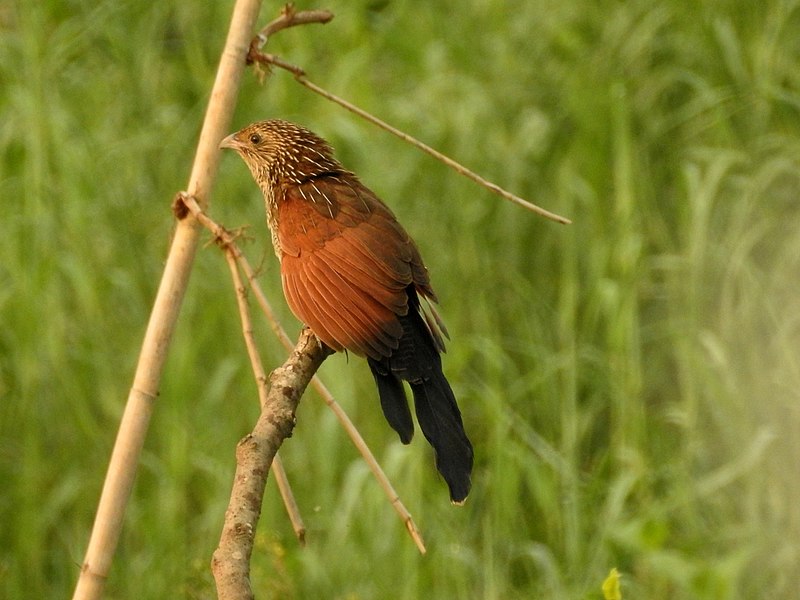
The Lesser Coucal is an iconic bird of the Cuculidae family. It has a wide distribution range and can be found in wetland habitats with plenty of grass, trees and shrubs.
This species stands out due to its relatively small size compared to other cuckoos as well as their less prominent bills and pale shaft streaks on the feathers of their heads and backs.
They have long claws which they use for perching or catching prey while hunting, making them efficient predators.
The calls made by these birds are quite distinct from those heard from other members of this genus – it sounds like two stones being knocked together.
All in all, this unique species is truly fascinating.Scientific classification:
| Kingdom | Animalia |
| Phylum | Chordata |
| Class | Aves |
| Order | Cuculiformes |
| Family | Cuculidae |
| Genus | Centropus |
| Species | C. bengalensis |
Also Featured In: Common Birds in India, Birds that Live in Tamil Nadu
2. Standardwing Bird-Of-Paradise
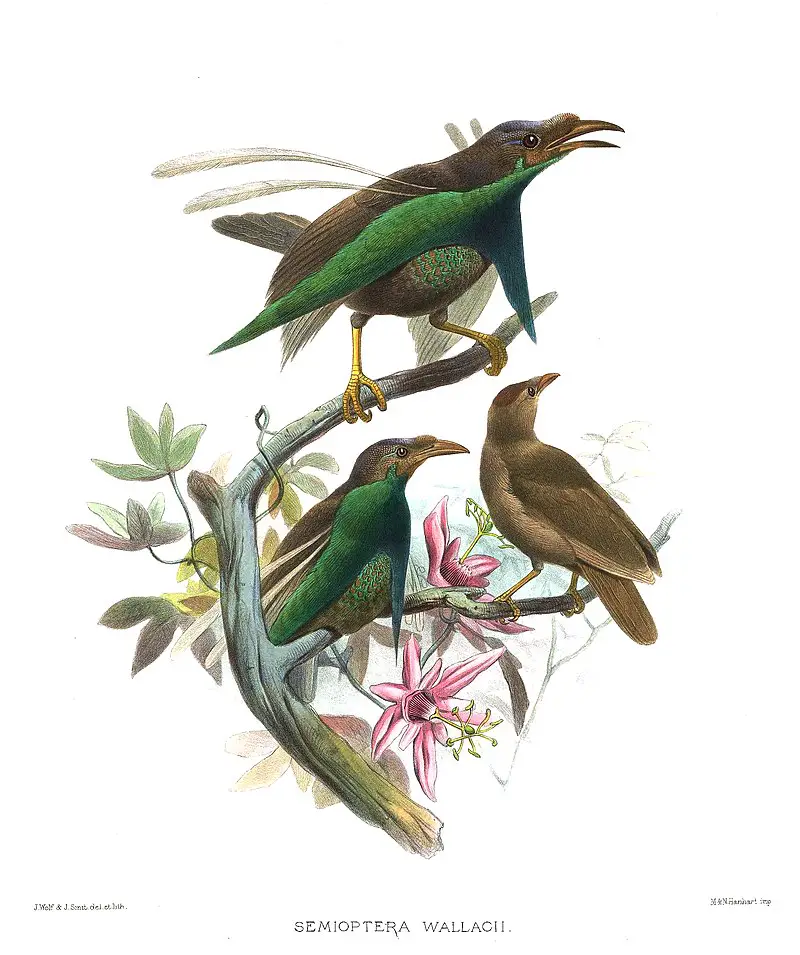
The Standardwing Bird-of-Paradise is a unique species of bird found in the tropical regions of Southeast Asia.
It was named by George Robert Gray from the British Museum after Alfred Russel Wallace, who discovered it during his travels through The Malay Archipelago in 1858.
This beautiful avian creature stands out for its vibrant colors and elaborate courtship display that includes bill clacking and fanning out.
Its wings to create an impressive ‘standard’ pattern with alternating black and white feathers. Its diet consists mainly of fruits, flowers, insects and small animals such as lizards or frogs.
Despite being widely sought after by collectors due to their beauty, habitat loss has made them vulnerable to extinction so conservation efforts are necessary if we want this fascinating species to survive.Scientific classification:
| Kingdom | Animalia |
| Phylum | Chordata |
| Class | Aves |
| Order | Passeriformes |
| Family | Paradisaeidae |
| Genus | Semioptera Gray, 1859 |
| Species | S. wallacii |
Also Featured In: Beautiful Indonesian Birds,
3. Blyth’s Hornbill
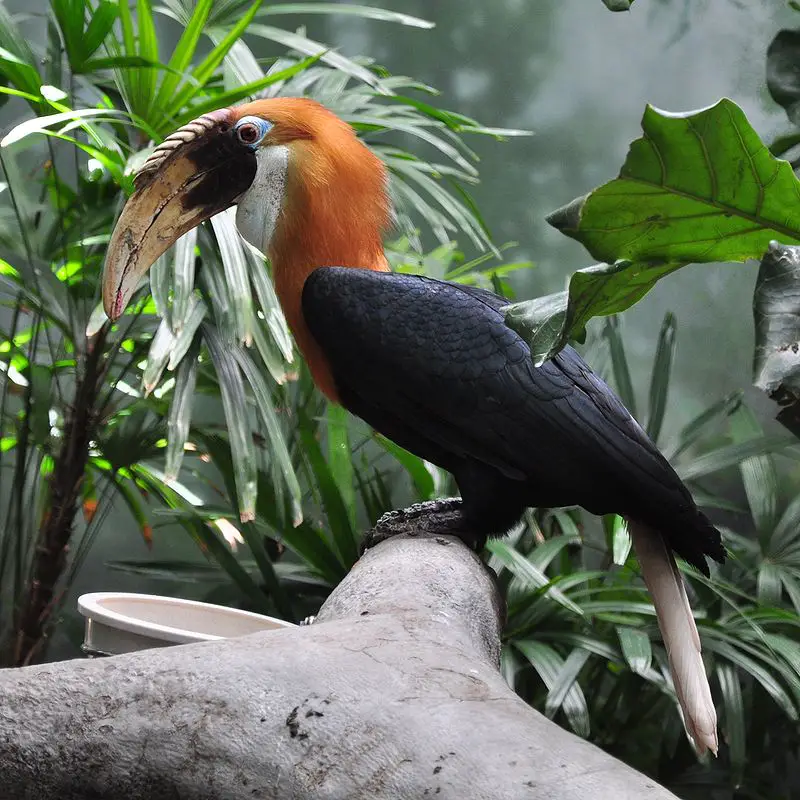
Blyth’s hornbill, or the Papuan Hornbill is a large species of bird that inhabits forests in Wallacea and Melanesia. It is also known as kokomo in Tok Pisin, and was previously placed under the genus Aceros.
This impressive bird has been often confused with its relative -the plain-pouched hornbill (Rhyticeros subruficollis)- but more recently it includes another family member: The Narcondam Hornbill (Rhyticeros narconda).
Blyth’s hornbills are characterized by their long curved beak and wingspan of up to three feet wide; they have dark feathers over most parts of their bodies except for yellowish ones on their tail tip, neck base and chin.
These majestic birds can make quite an impression when flying through a canopy.Scientific classification:
| Kingdom | Animalia |
| Phylum | Chordata |
| Class | Aves |
| Order | Bucerotiformes |
| Family | Bucerotidae |
| Genus | Rhyticeros |
| Species | R. plicatus |
Also Featured In: Papua New Guinea birds, Bougainville Island Birds You Need to See
4. Lesser Frigatebird
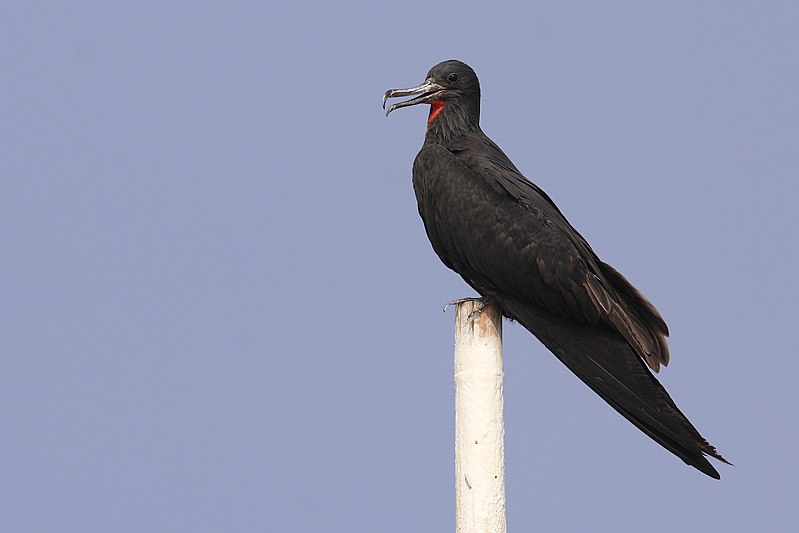
The Lesser Frigatebird is a seabird of the Fregatidae family and is known to be the smallest species in this group. It has brownish-black plumage, long narrow wings, and a forked tail.
This bird inhabits tropical and subtropical regions across the Indian Ocean, Pacific Ocean as well as off Brazil’s Atlantic Coast.
It feeds on fish taken from surface water or by plunge diving while flying low over shallow waters.
Its primary breeding grounds are located around islands with steep cliffs where it builds its nests out of twigs and grasses high up near ledges or crevices.
The lesser frigatebird can live for about 25 years due to their strong aerodynamic abilities which allow them to glide through air currents effortlessly thus conserving energy during flights that last days at a time.Scientific classification:
| Kingdom | Animalia |
| Phylum | Chordata |
| Class | Aves |
| Order | Suliformes |
| Family | Fregatidae |
| Genus | Fregata |
| Species | F. ariel |
Also Featured In: Mauritius birds, Birds that Live in the Ocean
5. Moustached Treeswift
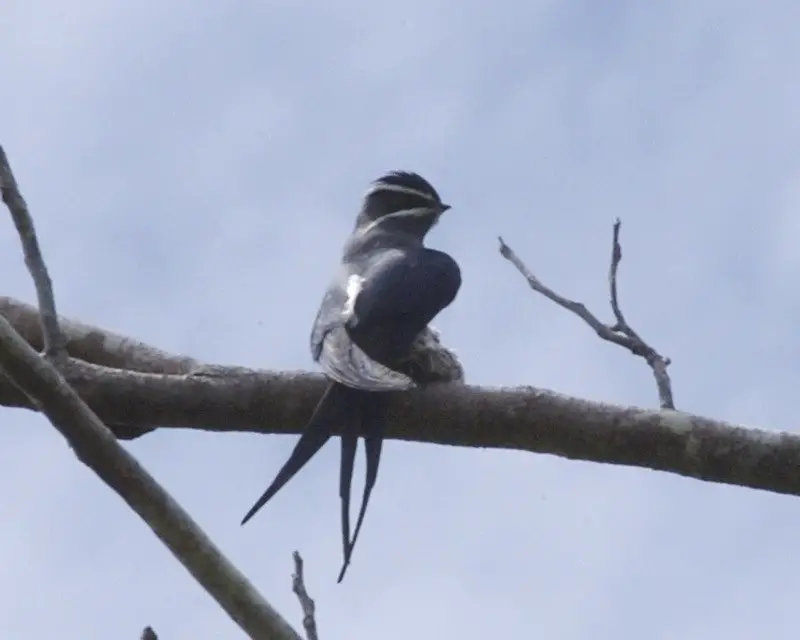
The Moustached treeswift is a species of bird found in the northern Moluccas, New Guinea, Bismarck and Solomon Islands archipelagos.
It belongs to family Hemiprocnidae and its natural habitats are subtropical or tropical moist lowland forests, mangrove forests as well as montane forests.
Its body length ranges from 24 cm – 27 cm with wingspan being approximately 46cm long.
This beautiful creature has moustache-like markings on both sides of its face which makes it look even more attractive when seen through binoculars or cameras.
The upper parts of the Moustached Treeswift are olive green while their underparts have yellowish hues making them stand out against other birds living nearby.
Overall this nocturnal bird is quite magnificent to witness perched atop branches searching for prey at night.Scientific classification:
| Kingdom | Animalia |
| Phylum | Chordata |
| Class | Aves |
| Order | Apodiformes |
| Family | Hemiprocnidae |
| Genus | Hemiprocne |
| Species | H. mystacea |
Also Featured In: Solomon Islands birds,
6. White-Bellied Cuckooshrike
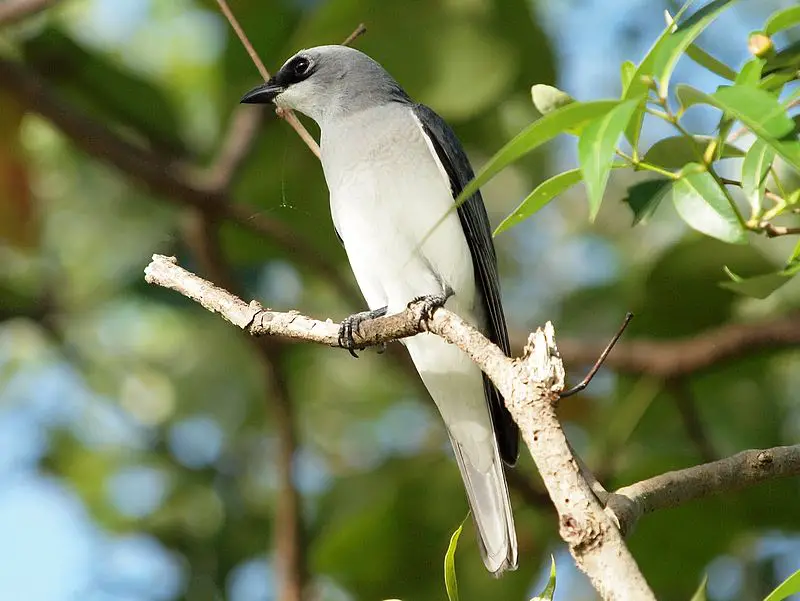
The white-bellied cuckooshrike is a captivating bird found in Australia, the Moluccas, New Guinea and the Solomon Islands.
It has an alluring appearance with its pale blue-grey head and upperparts combined with a short black mask that extends from its beak to its eyes (Lores), finishing off with a fine white rear eye-ring.
Its wings are rounded which help it soar through open woodlands usually as part of mixed species flocks.
This amazing creature enjoys eating insects such as butterflies and moths caught on wing at night or during twilight hours but will also feed on fruit when available.
The White bellied Cuckooshrike is truly an extraordinary example of nature’s beauty.Scientific classification:
| Kingdom | Animalia |
| Phylum | Chordata |
| Class | Aves |
| Order | Passeriformes |
| Family | Campephagidae |
| Genus | Coracina |
| Species | C. papuensis |
7. White-Breasted Woodswallow
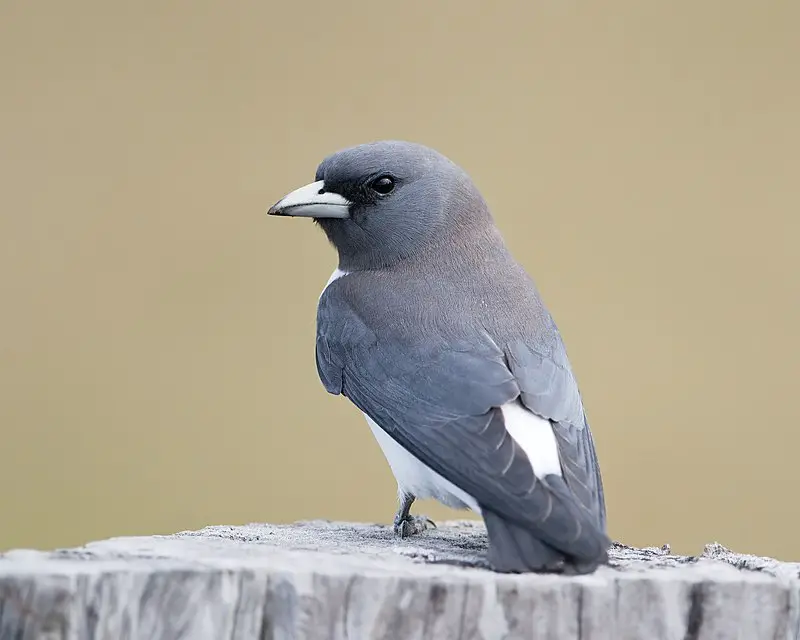
The White-breasted Woodswallow is a medium-sized passerine bird found in the Andaman Islands, Indonesia and Northern Australia.
Its name may be misleading as it does not belong to the family of true swallows but rather belongs to Artamidae which also includes butcherbirds, currawongs and Australian magpie.
These birds are mainly greyish brown with white belly patch and long wings having two pale bars on them.
They feed on insects like ants, beetles etc., captured from foliage or air during flight.
Breeding season for this species starts from October till December when they build their cup shaped nests out of twigs near tree trunks or branches usually high up in trees for protection against predators such as snakes or raptors.
Male woodswallows can often been seen singing loudly while displaying its aerial maneuvering capabilities trying to attract potential mates.Scientific classification:
| Kingdom | Animalia |
| Phylum | Chordata |
| Class | Aves |
| Order | Passeriformes |
| Family | Artamidae |
| Genus | Artamus |
| Species | A. leucorynchus |
Also Featured In: Brunei birds, Common Birds of Lombok
8. Common Cicadabird
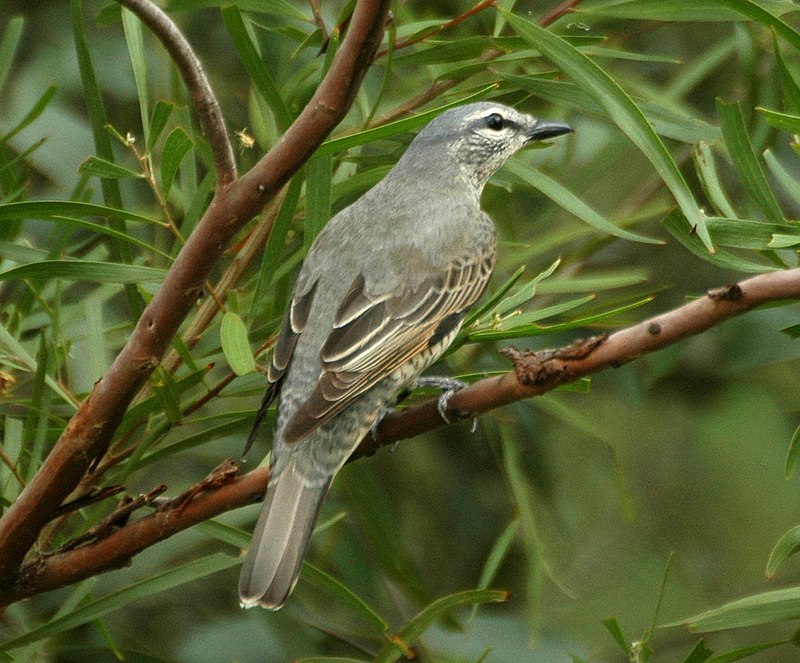
The Common Cicadabird is a species of bird found in Australia, Indonesia, New Guinea and the Solomon Islands. It typically inhabits temperate forest or subtropical moist lowland forests.
This slender-billed bird has olive green upperparts with white streaking on its back and wings and yellow under parts with some dark barring on its breast.
Its song consists of loud cicada like calls that can be heard from up to several hundred meters away.
The common cicadabird feeds primarily on insects such as caterpillars, grasshoppers and beetles which it catches by sallying out from an exposed perch before returning to the same spot once again.
Overall this small passerine makes for an interesting addition to any local wildlife area.Scientific classification:
| Kingdom | Animalia |
| Phylum | Chordata |
| Class | Aves |
| Order | Passeriformes |
| Family | Campephagidae |
| Genus | Edolisoma |
| Species | E. tenuirostre |
Also Featured In: Palau birds,
9. Shining Flycatcher
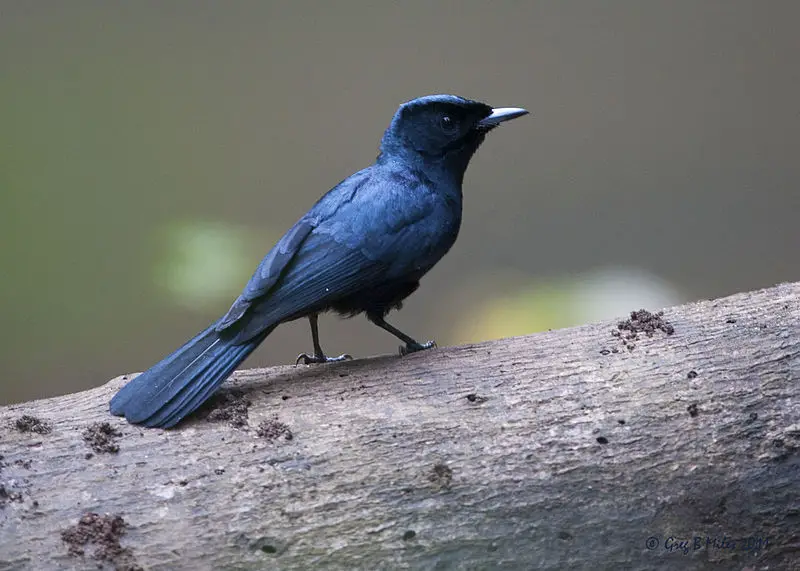
The Shining Flycatcher is a beautiful and slender bird with a long tail and fine bill. This species can be found in northern Australia, as well as in the Moluccas and the Bismarck Archipelago.
They typically inhabit subtropical or tropical moist lowland forests and mangrove forests. The male Shining Flycatcher is entirely glossy blue-black, while the female has a rich chestnut coloration above.
These birds are members of the Monarchidae family of songbirds.Scientific classification:
| Kingdom | Animalia |
| Phylum | Chordata |
| Class | Aves |
| Order | Passeriformes |
| Family | Monarchidae |
| Genus | Myiagra |
| Species | M. alecto |
Also Featured In: Birds that Charles Darwin Studied, Birds that Live in Sunshine Coast
10. Pale-Vented Bush-Hen
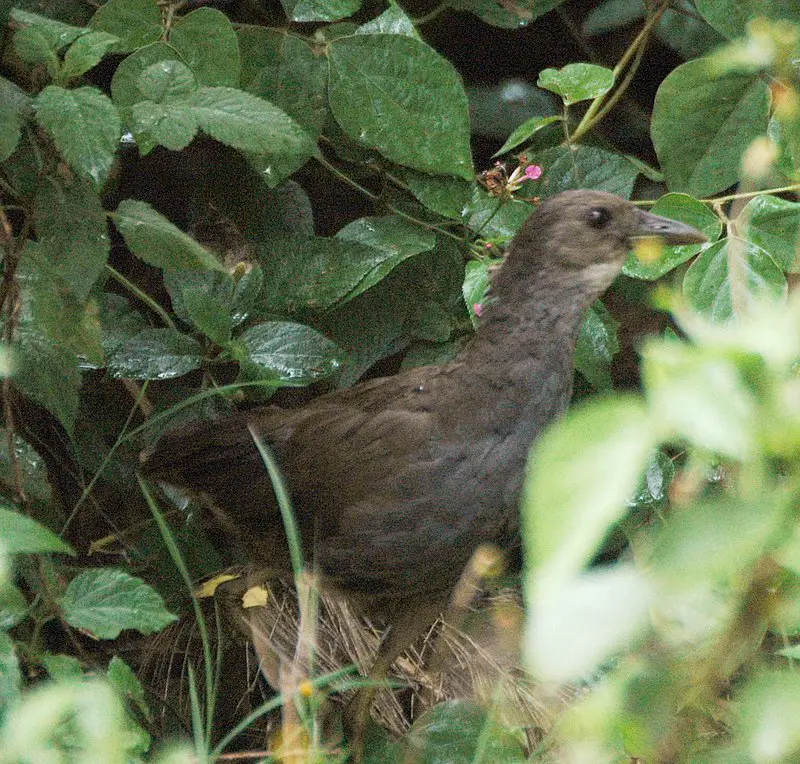
The pale-vented bush-hen is a medium sized waterbird that can be found in various regions such as Australia, the Moluccan Islands, New Guinea, the Bismarck Archipelago and the Solomon Islands.
It has a blue-grey colouration with a distinctive buff vent and undertail. This bird typically inhabits subtropical or tropical moist lowland forests.
Its body length ranges from 25 to 30 cm. Although relatively common in its natural habitat, the pale-vented bush-hen is not well known to many people.
It is an interesting bird that may be worth observing due to its unique colouration and distinct features. If you’re in the areas where these birds frequent, keep an eye out for this elusive species.Scientific classification:
| Kingdom | Animalia |
| Phylum | Chordata |
| Class | Aves |
| Order | Gruiformes |
| Family | Rallidae |
| Genus | Amaurornis |
| Species | A. moluccana |
Also Featured In: Common Townsville Birds,
11. Chattering Lory
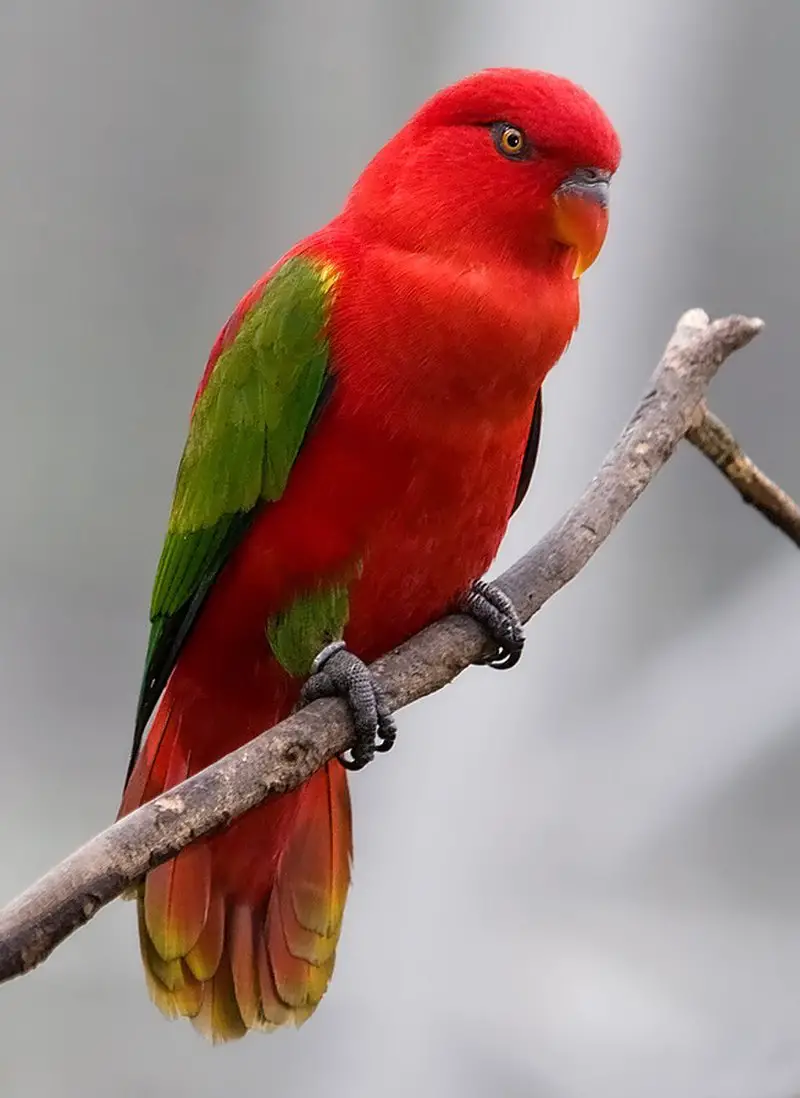
The chattering lory is a vibrant parrot found only in the North Maluku region of Indonesia. This forest-dwelling bird is at risk due to trapping for the cage-bird trade, making it a vulnerable species.
The yellow-backed lory, also known as L. g. flavopalliatus, is a subspecies of the chattering lory. Carl Linnaeus, a Swedish naturalist, first described this bird in 1758 in the tenth edition of his Systema Naturae.
With its colorful plumage and chatty nature, the chattering lory is a beloved species among bird enthusiasts. However, efforts must be made to protect this vulnerable bird from the threats it faces.Scientific classification:
| Kingdom | Animalia |
| Phylum | Chordata |
| Class | Aves |
| Order | Psittaciformes |
| Family | Psittaculidae |
| Genus | Lorius |
| Species | L. garrulus |
Also Featured In: Case Birds that Live in with Us,
12. Grey-Cheeked Green Pigeon
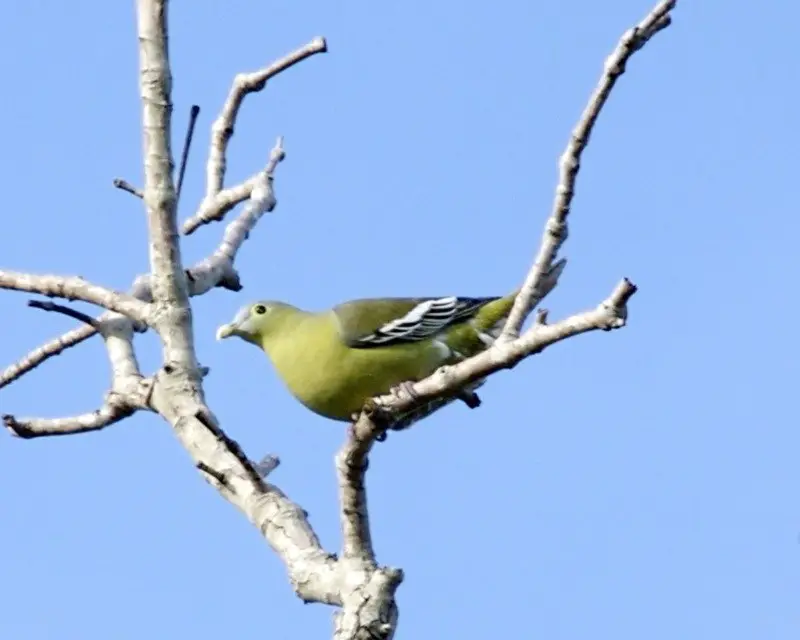
The Grey-cheeked green pigeon is a member of the Columbidae family and can only be found in Indonesia. Known for its beautiful grey and green feathers, this bird is a true gem of Southeast Asian aviary.
With an average size of 31 cm and a diet that mainly consists of fruit, it is a gentle bird that rarely hunts other creatures. Its unique features include grey cheeks and its soft, subtle cooing sounds that can be heard from afar.
This charming bird is a great source of awe and fascination for birdwatchers and nature enthusiasts alike.Scientific classification:
| Kingdom | Animalia |
| Phylum | Chordata |
| Class | Aves |
| Order | Columbiformes |
| Family | Columbidae |
| Genus | Treron |
| Species | T. griseicauda |
Also Featured In: Common Birds of Indonesia,
13. Blue-Capped Fruit Dove
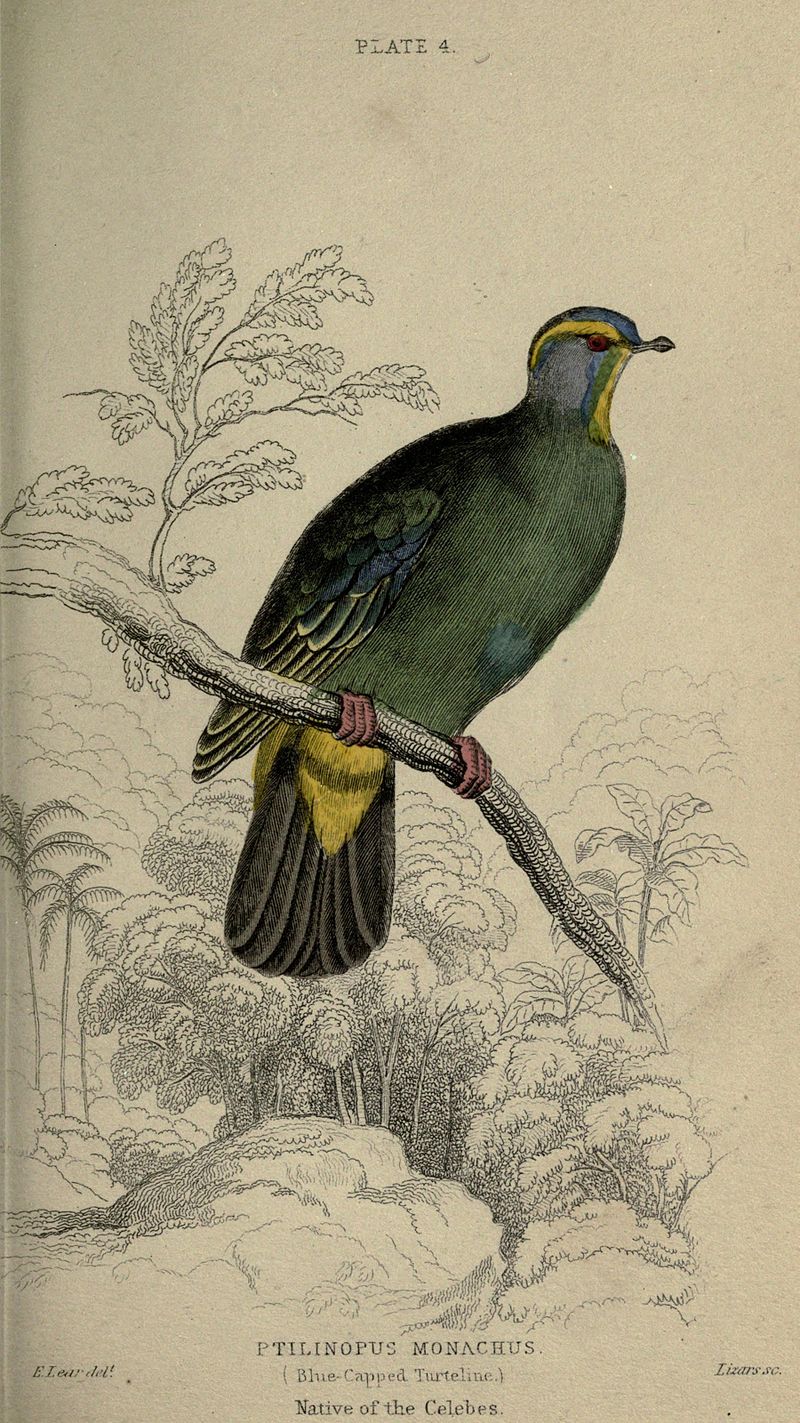
The Blue-capped fruit dove is a unique species that can be found in the northern Maluku Islands. This bird is a member of the Columbidae family and is commonly found in subtropical or tropical moist lowland forests.
They also thrive in subtropical or tropical mangrove forests and rural gardens. Unfortunately, they face the threat of habitat loss due to human activity. The bird has a striking blue cap that is a distinguishing feature from other birds.
This small fruit dove is an important part of its ecosystem as it helps to disperse seeds from the fruit it consumes.
Despite its importance, the blue-capped fruit dove is facing threats to its survival due to habitat destruction. Conservation efforts need to be implemented to protect this unique and valuable bird species.Scientific classification:
| Kingdom | Animalia |
| Phylum | Chordata |
| Class | Aves |
| Order | Columbiformes |
| Family | Columbidae |
| Genus | Ptilinopus |
| Species | P. monacha |
14. Ivory-Breasted Pitta
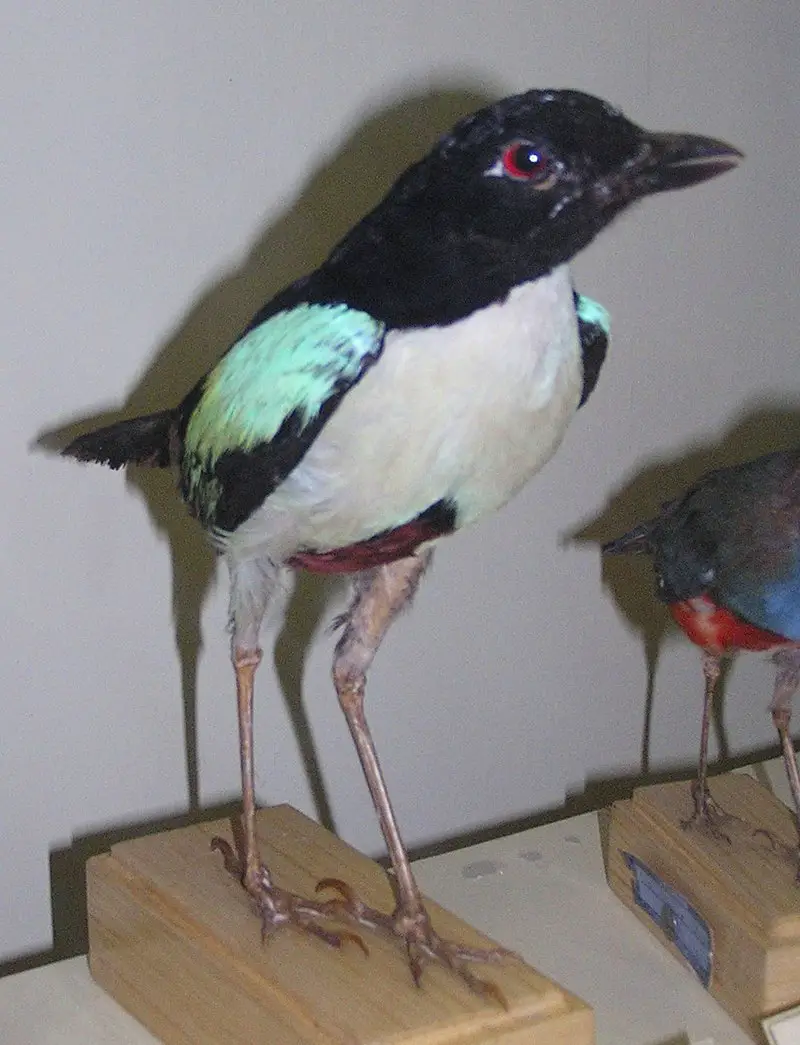
The Ivory-breasted pitta, also known as Pitta maxima, is a member of the Pittidae family and can be found exclusively in North Maluku, Indonesia. This bird is commonly referred to as Paok halmahera by locals.
Ivory-breasted pittas thrive in subtropical or tropical moist lowland forests, which serves as their natural habitat. Two subspecies of this bird are known to exist. The Ivory-breasted pitta is a striking bird with a colorful and distinctive appearance.
It has a white breast contrasting with a blue crown and black mask. Beyond their appearance, Ivory-breasted pittas are known for their unusual and melodious songs.
Their unique calls often resemble human sounds, making them a fascinating bird to observe in the wild.
Although rare, Ivory-breasted pittas are beloved by birdwatchers and nature enthusiasts.Scientific classification:
| Kingdom | Animalia |
| Phylum | Chordata |
| Class | Aves |
| Order | Passeriformes |
| Family | Pittidae |
| Genus | Pitta |
| Species | P. maxima |
15. Halmahera Paradise-Crow
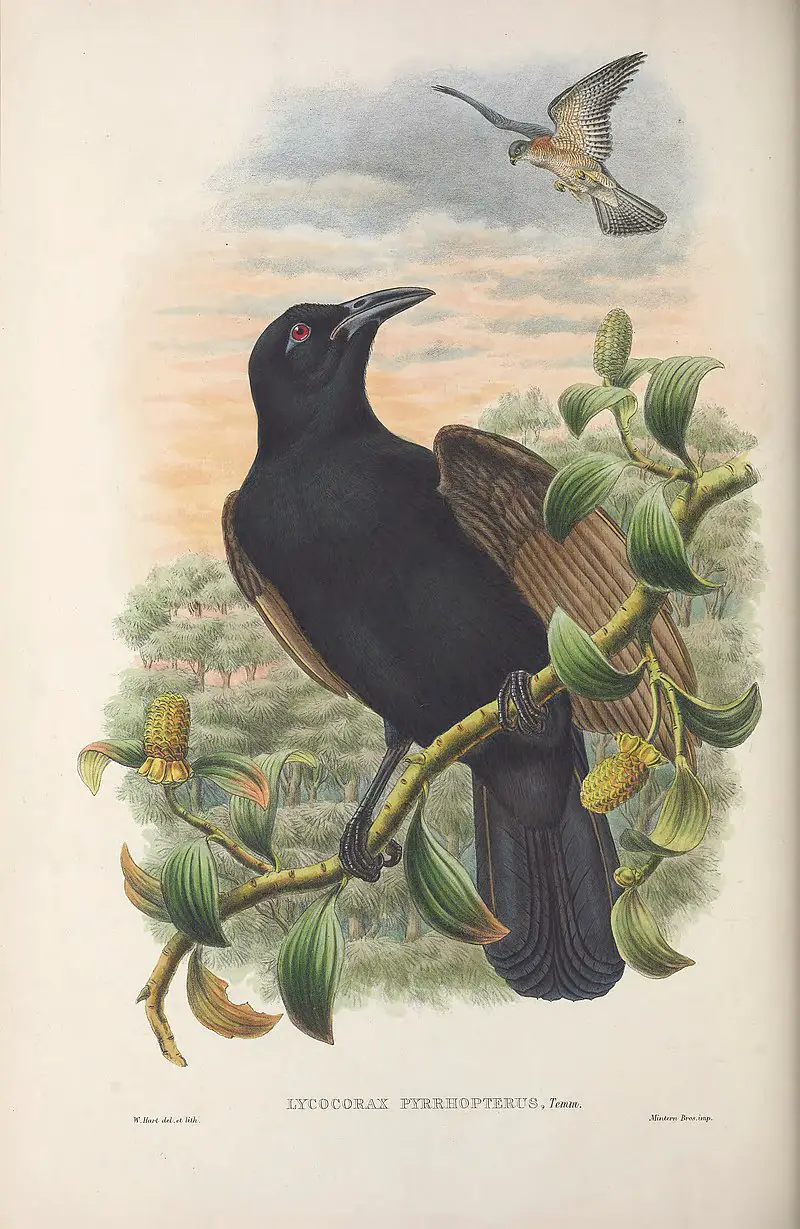
The Halmahera paradise-crow, also known as the silky crow, is a medium-sized bird found in the lowland forests of Northern Maluku, Indonesia. Despite being a crow-like bird, it is one of the few monogamous birds-of-paradise species.
Their diet mainly consists of fruits and arthropods. These forest-dwelling birds are restricted to Halmahera and Morotai islands, making them endemic to this region.
Their striking black plumage, coupled with a silky texture, has earned them the nickname “silky crow.”
The Halmahera paradise-crow is a vital component of the forest ecosystem, as it helps in seed dispersal and insect control.
However, habitat loss and hunting have led to a decline in their population, making them a vulnerable species. Conservation efforts are necessary to ensure their continued survival.Scientific classification:
| Kingdom | Animalia |
| Phylum | Chordata |
| Class | Aves |
| Order | Passeriformes |
| Family | Paradisaeidae |
| Genus | Lycocorax |
| Species | L. pyrrhopterus |
Also Featured In: Beautiful Birds Found in Paradise Island,
16. Goliath Coucal
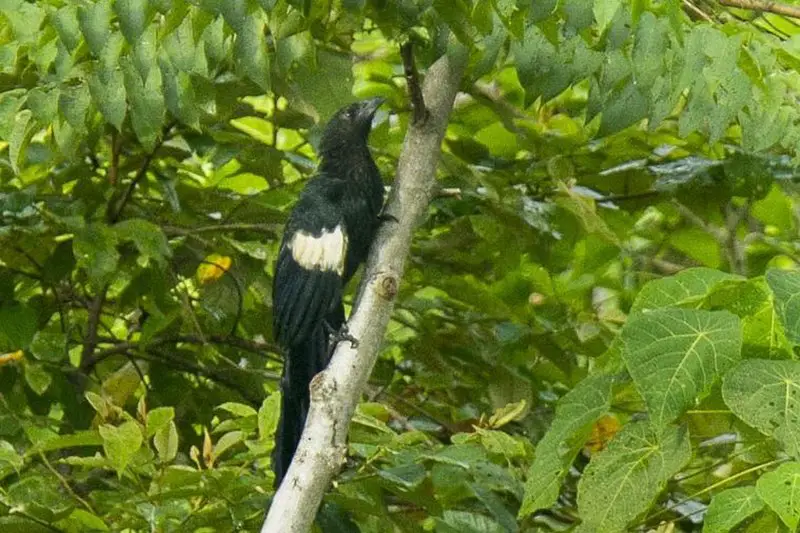
The Goliath coucal bird belongs to the cuckoo family and is found in the northern Maluku Islands. This amazing bird is known for its large size and unique features.
With its long strong legs and powerful wings, the coucal has a great ability to fly and hunt for prey. Its unique features include its curved bill and colorful plumage, which makes it easily recognizable.
Due to its size, the Goliath coucal has a commanding presence in the animal kingdom. Its habitat is mainly in the dense forests of the Maluku Islands, where it can hunt for insects, small animals, and even small birds.
Despite its size, it is a very agile bird and can move quickly and easily through the trees. This bird is fascinating to observe and is a great addition to the biodiversity of the Maluku Islands.Scientific classification:
| Kingdom | Animalia |
| Phylum | Chordata |
| Class | Aves |
| Order | Cuculiformes |
| Family | Cuculidae |
| Genus | Centropus |
| Species | C. goliath |
17. Moluccan Owlet-Nightjar
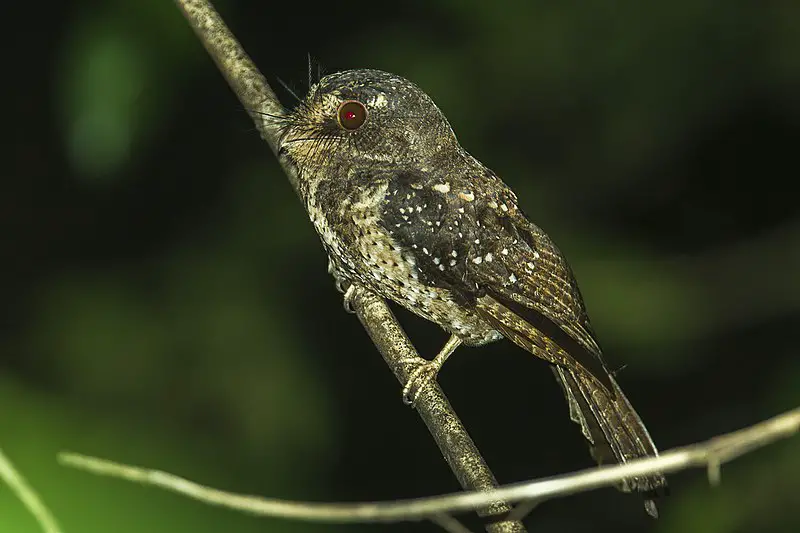
The Moluccan owlet-nightjar, otherwise known as the long-whiskered owlet-nightjar, is a unique bird found only in the northern Moluccas. This species belongs to the Aegothelidae family and can thrive in subtropical or tropical moist lowland or montane forests.
Not much is known about this bird apart from its distinctive long whiskers and brownish-black feathers. Its cute appearance is somewhat misleading considering that it is an apex predator, feeding mostly on insects.
Recently, there have been concerns about its declining population as its natural habitat continues to shrink due to human activities.
Conservation efforts are being undertaken to protect this species and ensure its survival in the future.Scientific classification:
| Kingdom | Animalia |
| Phylum | Chordata |
| Class | Aves |
| Clade | Strisores |
| Order | Aegotheliformes |
| Family | Aegothelidae |
| Genus | Aegotheles |
| Species | A. crinifrons |
18. Sombre Kingfisher
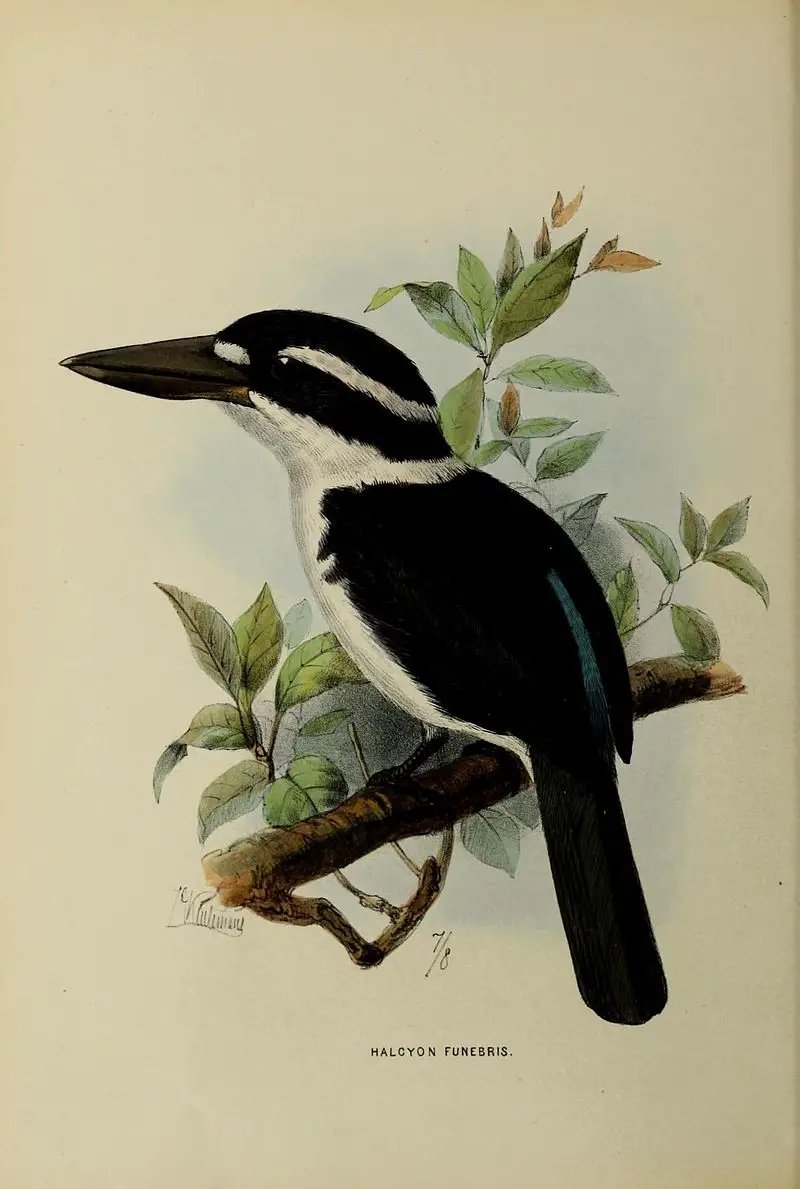
The Sombre kingfisher, found only on the island of Halmahera in Indonesia, is a large bird belonging to the Alcedinidae family. Its preferred habitats include moist lowland forest, mangrove forest, swamps and plantations.
Unfortunately, like many other bird species, the Sombre kingfisher is threatened by habitat loss.
Despite its name, this bird is a sight to behold with its vibrant plumage of blue and green feathers. Its beak is long and pointed, ideal for catching fish and small crustaceans in the water.
Conservation efforts are needed to preserve the remaining habitats of this spectacular bird species.Scientific classification:
| Kingdom | Animalia |
| Phylum | Chordata |
| Class | Aves |
| Order | Coraciiformes |
| Family | Alcedinidae |
| Subfamily | Halcyoninae |
| Genus | Todiramphus |
| Species | T. funebris |
19. Dusky-Brown Oriole
The Dusky-brown oriole is a bird belonging to the Oriolidae family, making its home in the lush subtropical and tropical forests of North Maluku. Its unique and endemic natural habitat is vital to the survival of this species.
Also known as the Dusky oriole, Gray’s oriole, Halmahera oriole, or Moluccan oriole, it has a dusky-brown plumage, and its lovely song is its characteristic trait.
The Dusky-brown oriole embodies the beauty and diversity of the natural world, and its conservation is essential for the continued existence of this unique and important bird species.Scientific classification:
| Kingdom | Animalia |
| Phylum | Chordata |
| Class | Aves |
| Order | Passeriformes |
| Family | Oriolidae |
| Genus | Oriolus |
| Species | O. phaeochromus |
20. Scarlet-Breasted Fruit Dove
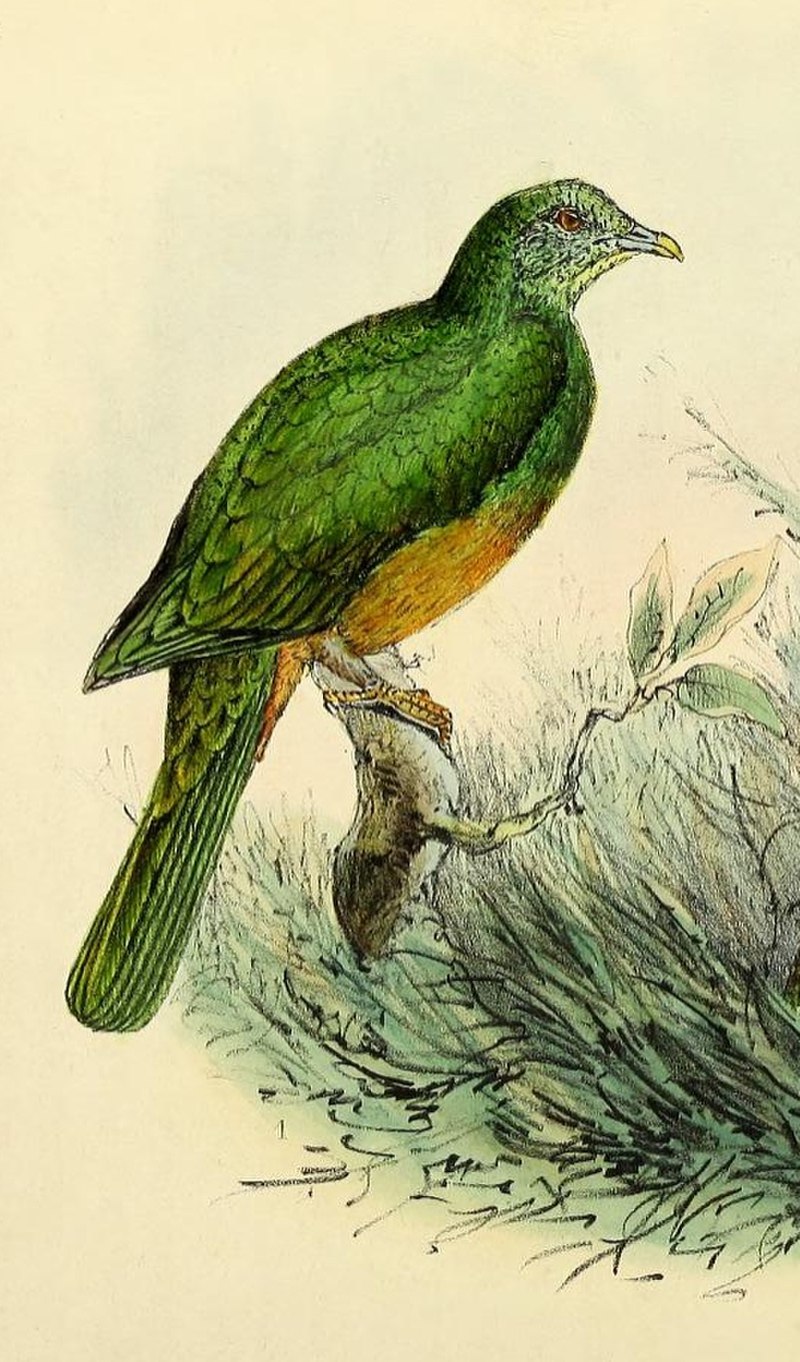
The Scarlet-breasted Fruit Dove is a bird species found exclusively in the northern Moluccas of Indonesia. It lives in subtropical or tropical moist lowland forests as its natural habitat.
This bird belongs to the Columbidae family and is of least concern in terms of its extinction risk, according to the International Union for Conservation of Nature Red List. The species was named Ptilinopus bernsteinii by Hermann Schlegel in 1863.
The particular name “bernsteinii†is derived from the German word for amber, probably due to its colorful and beautiful plumage.
Due to deforestation in its habitat, the population of Scarlet-breasted Fruit Doves may decrease in the future, and so conservation efforts may be needed to protect this bird.Scientific classification:
| Kingdom | Animalia |
| Phylum | Chordata |
| Class | Aves |
| Order | Columbiformes |
| Family | Columbidae |
| Genus | Ptilinopus |
| Species | P. bernsteinii |
21. Cream-Throated White-Eye
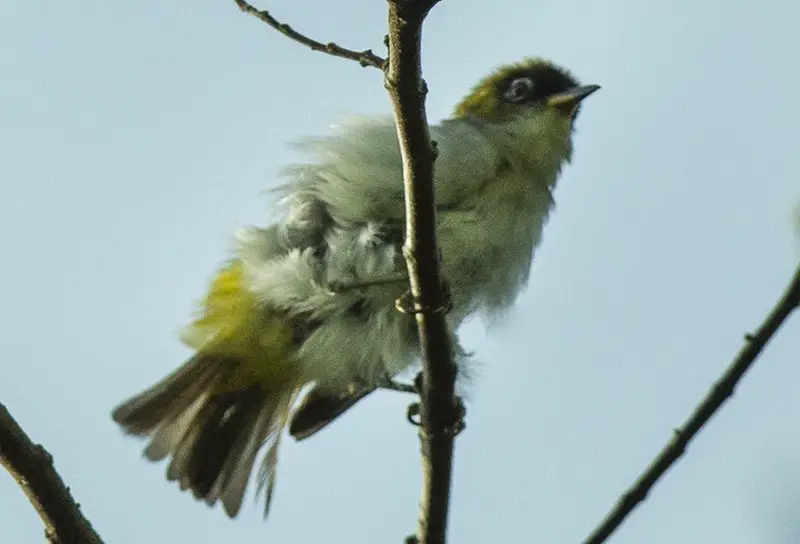
The Cream-throated white-eye is a bird species that belongs to the Zosteropidae family. It can only be found in the northern Moluccas, particularly on the Indonesian island of Maluku Utara.
This bird species thrives in subtropical or tropical environments, such as mangrove forests and moist lowland forests. The Cream-throated white-eye has a distinct cream-colored throat, which sets it apart from other similarly-sized birds.
Its overall coloration is mostly olive-green or grayish, making it easier to blend in with its surroundings. While these birds are considered to be small, they tend to be quite active, often seen hopping around trees and shrubs while foraging for food.
Despite being part of a family of small passerines, the Cream-throated white-eye is known to have exceptional vocal abilities, producing sweet and melodic chirps that can be heard in the forests of the Maluku Utara.Scientific classification:
| Kingdom | Animalia |
| Phylum | Chordata |
| Class | Aves |
| Order | Passeriformes |
| Family | Zosteropidae |
| Genus | Zosterops |
| Species | Z. atriceps |
22. Long-Billed Crow
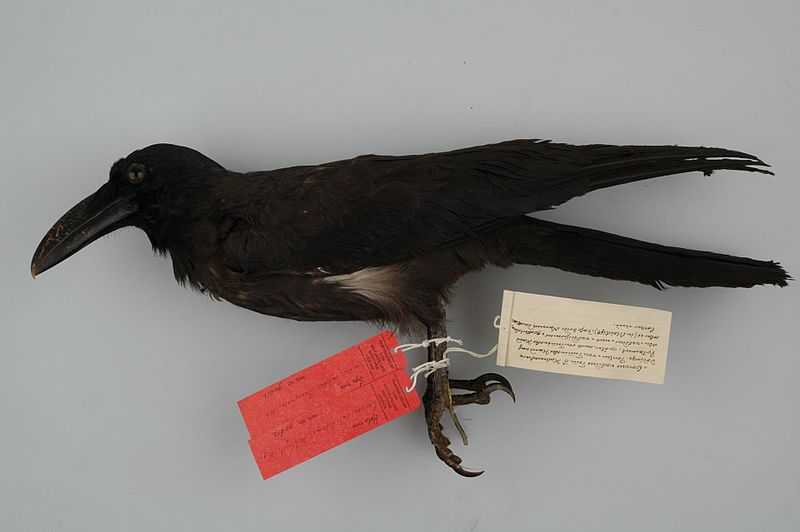
The Long-billed crow, also known as Corvus validus, is native to the Northern Maluku Islands. With its glossy plumage, a large bill, and white irises, this crow is striking in appearance.
Despite its large size, it has a relatively short tail, measuring between 45-53 cm. Unfortunately, this bird is classified as a “near-threatened species” by the International Union for Conservation of Nature.
Their population is declining over time, and their habitat is being destroyed by deforestation, which is causing them to lose their nesting and feeding grounds.
To protect this beautiful bird, conservation efforts must be made to prevent the destruction of its habitat and to ensure its continued existence in the wild.Scientific classification:
| Kingdom | Animalia |
| Phylum | Chordata |
| Class | Aves |
| Order | Passeriformes |
| Family | Corvidae |
| Genus | Corvus |
| Species | C. validus |
23. Cinnamon-Bellied Imperial Pigeon
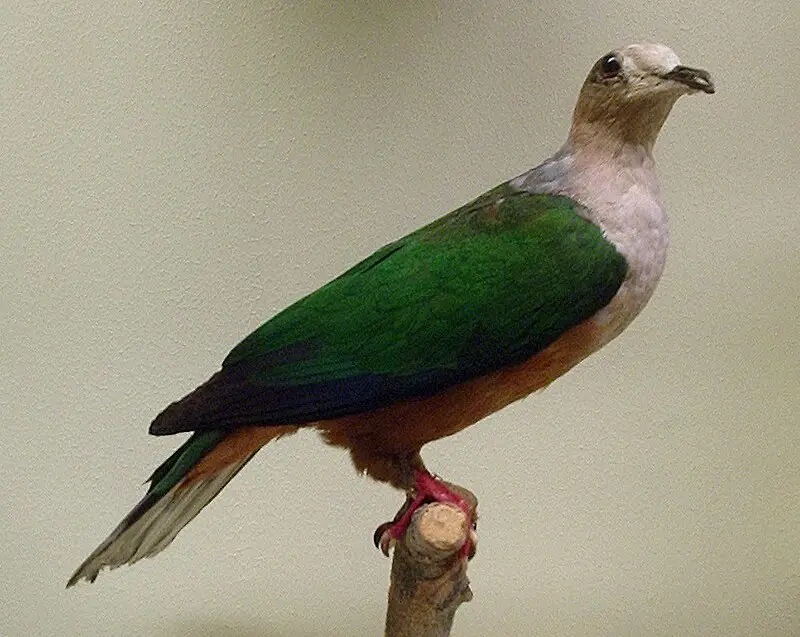
The Cinnamon-bellied imperial pigeon (Ducula basilica) is a rare bird found only in the northern Moluccas. It prefers to live in subtropical or tropical moist lowland forests.
The bird is quite splendid with cinnamon colored belly and a beautiful overall appearance. It was first described by Charles Lucien Bonaparte in 1854.
Sadly, due to habitat destruction and hunting, the cinnamon-bellied imperial pigeon is currently at risk of extinction.
Conservation efforts are needed to save this unique species.Scientific classification:
| Kingdom | Animalia |
| Phylum | Chordata |
| Class | Aves |
| Order | Columbiformes |
| Family | Columbidae |
| Genus | Ducula |
| Species | D. basilica |
24. Moluccan Scops Owl
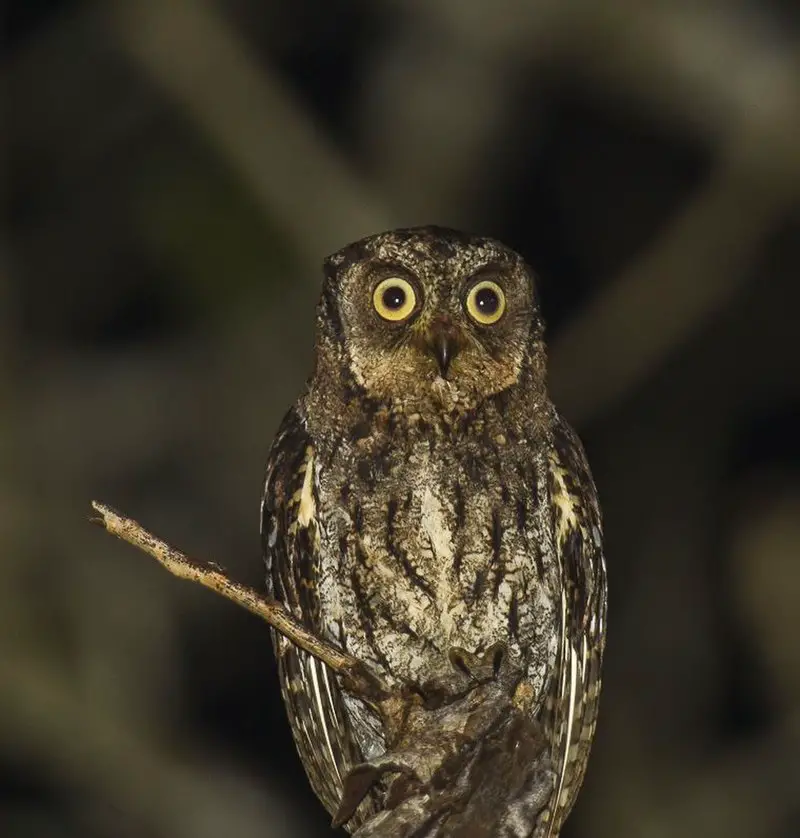
The Moluccan scops owl is a species of owl found in the Maluku and Lesser Sunda Islands in Indonesia. It bears a close resemblance to the Rinjani scops owl.
This species of owl has several subspecies, including the Wetar scops owl, which was previously considered a subspecies but has since been split. The Moluccan scops owl has distinctive markings and an intricate set of feathers.
It is a skilled hunter, feeding on a variety of prey including insects, small mammals, and birds.
This owl species has adapted well to its habitat and is not considered a threatened species. Its distinct calls can often be heard echoing throughout the night in its natural range.Scientific classification:
| Kingdom | Animalia |
| Phylum | Chordata |
| Class | Aves |
| Order | Strigiformes |
| Family | Strigidae |
| Genus | Otus |
| Species | O. magicus |
25. Moluccan Hanging Parrot
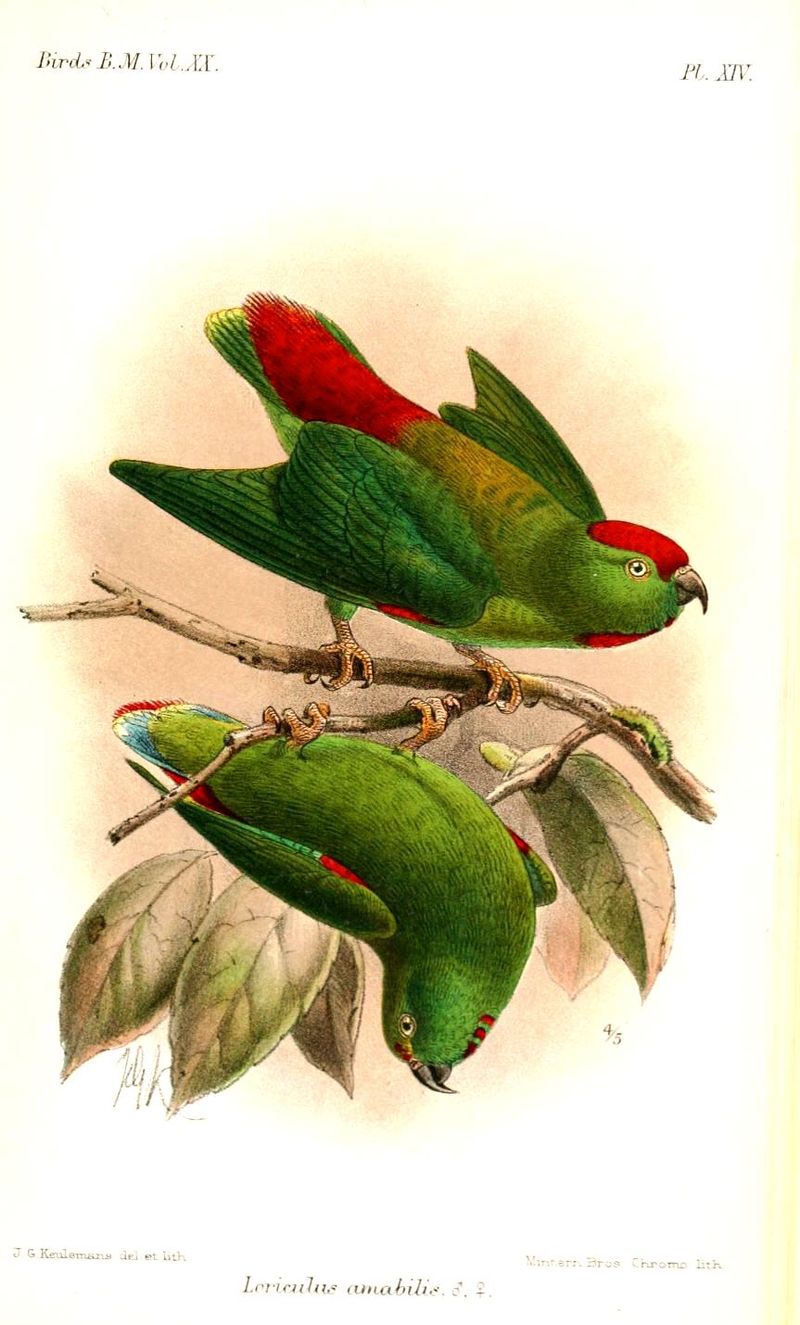
The Moluccan hanging parrot is a small bird found in the forests of Halmahera, Bacan and Morotai in Indonesia. It is distinguishable from other hanging parrots by its unique plumage and size, measuring a mere 11 cm.
This parrot is endemic to the region and is not found anywhere else in the world. Despite its small size, it is known for its vibrant and colorful feathers, making it a popular choice among bird enthusiasts.
Its habitat is typically in or near the forested areas, where it can find food and shelter.
Due to its limited range and population size, efforts are being made to conserve this bird and protect its habitat.Scientific classification:
| Kingdom | Animalia |
| Phylum | Chordata |
| Class | Aves |
| Order | Psittaciformes |
| Family | Psittaculidae |
| Genus | Loriculus |
| Species | L. amabilis |
26. Blue-And-White Kingfisher
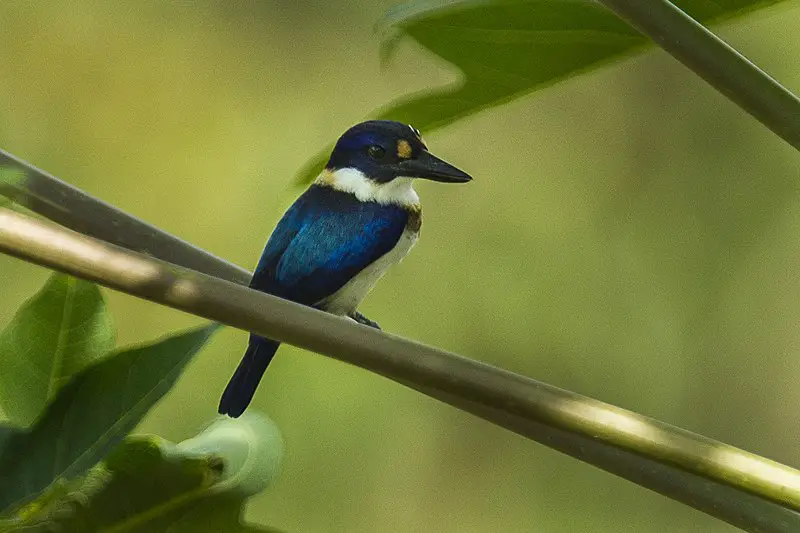
The Blue-and-white kingfisher is a bird that belongs to the Alcedinidae family. It is native to North Maluku in Indonesia and can be spotted on various islands including Morotai, Ngelengele, Halmahera, Damar, Ternate, Tidore, Moti, Bacan, Obi, and Obilatu.
This bird species is known for its blue and white appearance and is found in subtropical or tropical mangrove forests. Its natural habitat is likely to be near water bodies due to its diet, which mainly consists of fish.
The Blue-and-white kingfisher is an endemic species, which means it is only found in one particular area, making its conservation very important.
Overall, this bird species is a fascinating subject for birdwatchers and nature enthusiasts alike.Scientific classification:
| Kingdom | Animalia |
| Phylum | Chordata |
| Class | Aves |
| Order | Coraciiformes |
| Family | Alcedinidae |
| Subfamily | Halcyoninae |
| Genus | Todiramphus |
| Species | T. diops |
27. Dusky Megapode
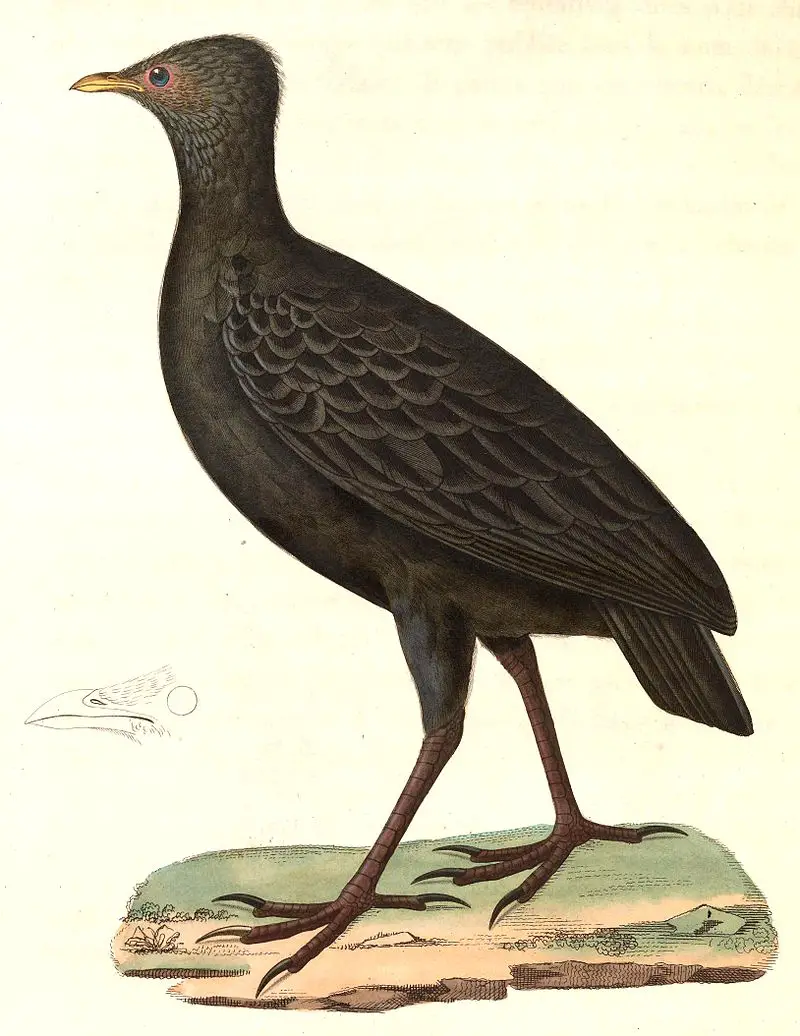
The Dusky megapode, also called the Dusky scrubfowl or Common megapode, is a blackish, medium-sized bird measuring about 41 cm long.
Both male and female look similar, with a short pointed crest, red facial skin, dark legs, brown irises, and a dark brown and yellow bill.
These birds inhabit a range of forest and swamp habitats, including mangroves, in Maluku and Raja. They are primarily a terrestrial species and generally avoid water.
While these birds are not considered globally threatened, they may face local pressures from habitat loss or hunting.
The Dusky megapode is known for its impressive nesting behavior, where the birds use the heat of the sun or composting vegetation to incubate their eggs rather than their own body heat.Scientific classification:
| Kingdom | Animalia |
| Phylum | Chordata |
| Class | Aves |
| Order | Galliformes |
| Family | Megapodiidae |
| Genus | Megapodius |
| Species | M. freycinet |
Also Featured In: Waigeo Island Birds,
28. Moluccan Cuckooshrike
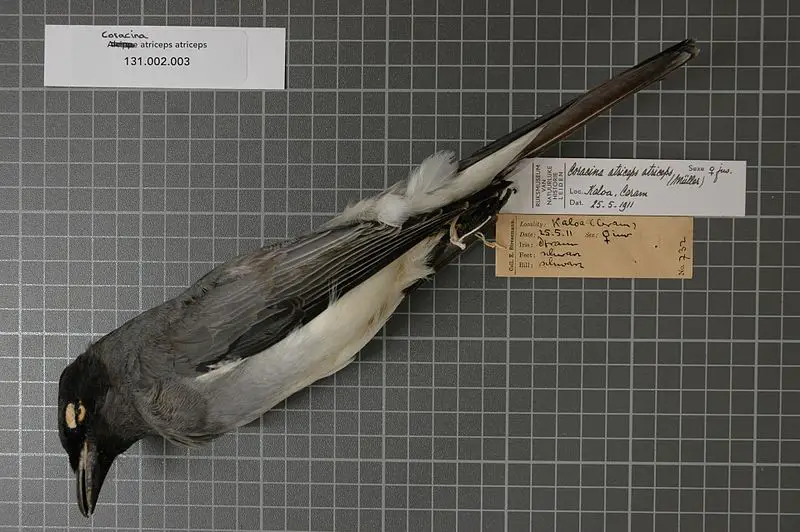
The Moluccan cuckooshrike is a unique bird species that can only be found in Indonesia. It belongs to the family of Campephagidae, and it is scientifically known as Coracina atriceps.
The bird’s natural habitat is in subtropical and tropical moist lowland forests. With its unique features and remarkable beauty, this bird species is commonly admired by birdwatchers all over the world.
Its black crown, white throat, and greyish-black feathers make it distinctive and easy to identify. This bird is an insectivore, and it mainly feeds on insects, caterpillars, and spiders. The conservation status of the Moluccan cuckooshrike is still vulnerable.
Therefore, efforts should be made to protect this species from extinction.Scientific classification:
| Kingdom | Animalia |
| Phylum | Chordata |
| Class | Aves |
| Order | Passeriformes |
| Family | Campephagidae |
| Genus | Coracina |
| Species | C. atriceps |
29. White-Naped Monarch
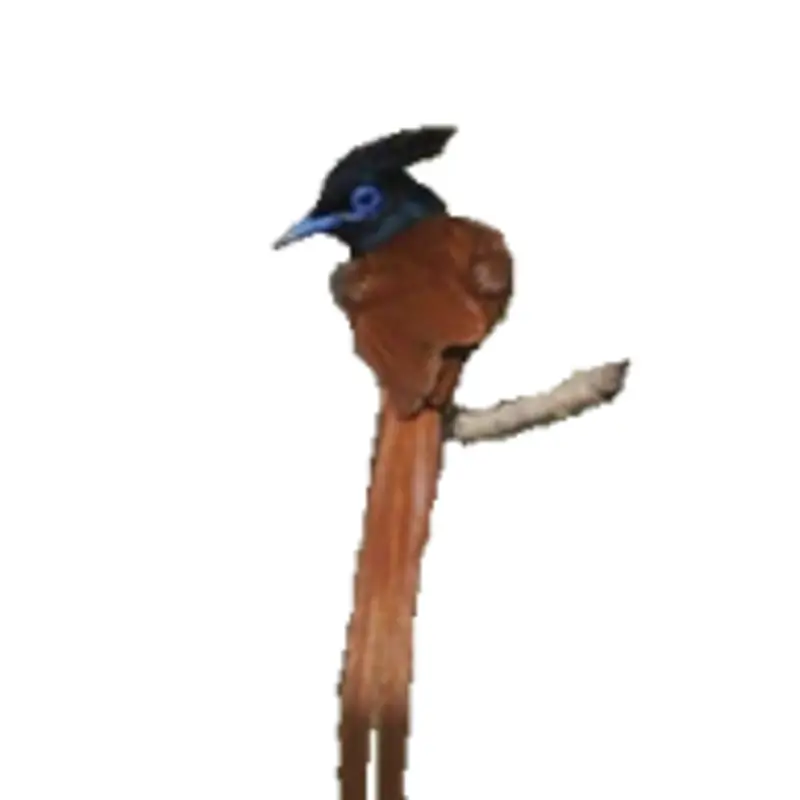
The White-naped monarch is a bird found only in the Indonesian Maluku Islands. Its natural habitat is the subtropical or tropical moist lowland forests.
It was initially categorized under the genus Monarcha, but in 2009, it was moved to the Carterornis genus. Its scientific name is Carterornis pileatus. The White-naped monarch belongs to the Monarchidae family, which is known for its distinctive songs and brilliant plumage.
The bird is known for its white nape, distinguishing it from other monarch species. Its diet mainly consists of insects, which it catches mid-air.
The White-naped monarch population is stable, and it is not considered an endangered species as of now. However, with continuous deforestation due to human activity, its habitat is under threat.
The White-naped monarch is a vital part of the Maluku Islands’ ecosystem and must be conserved for its ecological and aesthetic value.Scientific classification:
| Kingdom | Animalia |
| Phylum | Chordata |
| Class | Aves |
| Order | Passeriformes |
| Family | Monarchidae |
| Genus | Carterornis |
| Species | C. pileatus |
30. Black-Faced Munia
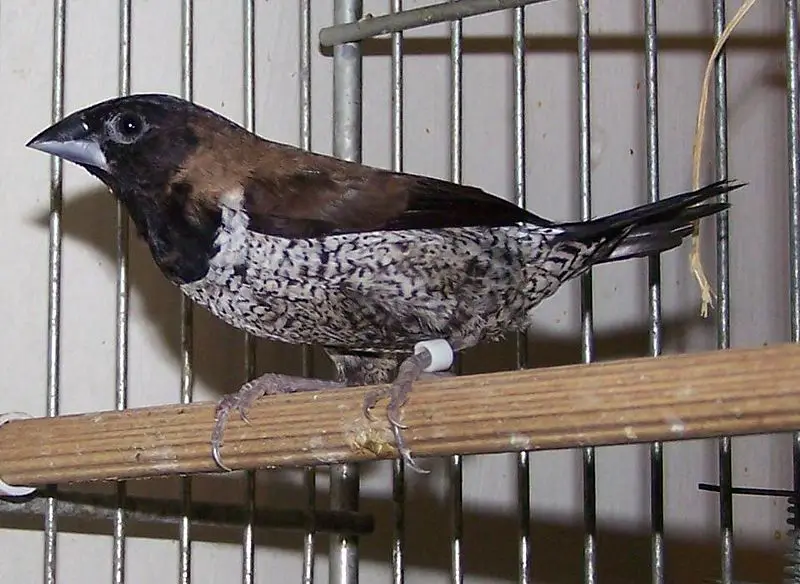
The black-faced munia is a small bird belonging to the finch family. It is commonly found in Indonesia and East Timor, inhabiting various landscapes such as forests, grasslands, savannahs, and even artificial settings like parks and gardens.
The bird was first identified by a Swedish naturalist, Carl Linnaeus, in 1766. Despite its widespread occurrence, the black-faced munia’s conservation status has been evaluated by the International Union for Conservation of Nature (IUCN).
Further information about this evaluation is not provided in the given info.Scientific classification:
| Kingdom | Animalia |
| Phylum | Chordata |
| Class | Aves |
| Order | Passeriformes |
| Family | Estrildidae |
| Genus | Lonchura |
| Species | L. molucca |
31. Drab Whistler
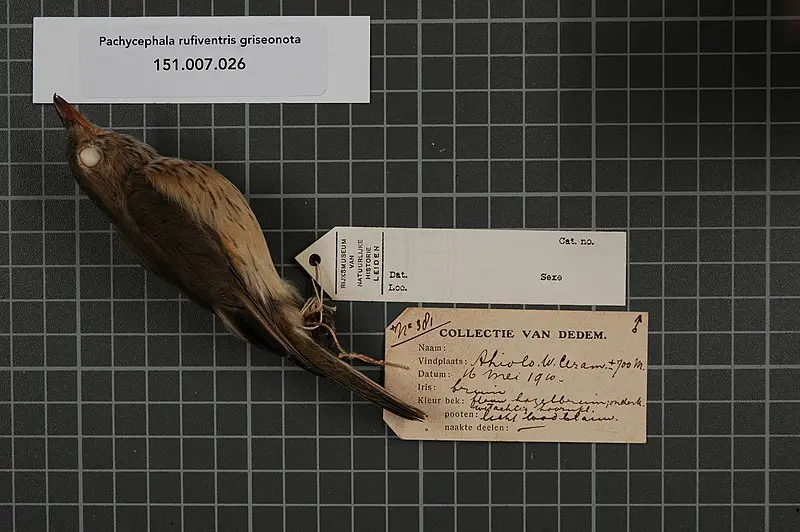
The Drab whistler bird is a member of the Pachycephalidae family and can be found in the Maluku Islands. This bird species prefers to reside in subtropical or tropical moist lowland forests.
Although it is sometimes considered as a few subspecies of the Rufous whistler, there are five recognized subspecies of the Drab whistler. The cinnamon-breasted whistler is sometimes also considered a subspecies of the Drab Whistler.
Overall, the Drab whistler is a unique bird species with its own specific habitat and subspecies.Scientific classification:
| Kingdom | Animalia |
| Phylum | Chordata |
| Class | Aves |
| Order | Passeriformes |
| Family | Pachycephalidae |
| Genus | Pachycephala |
| Species | P. griseonota |
32. Moluccan Starling
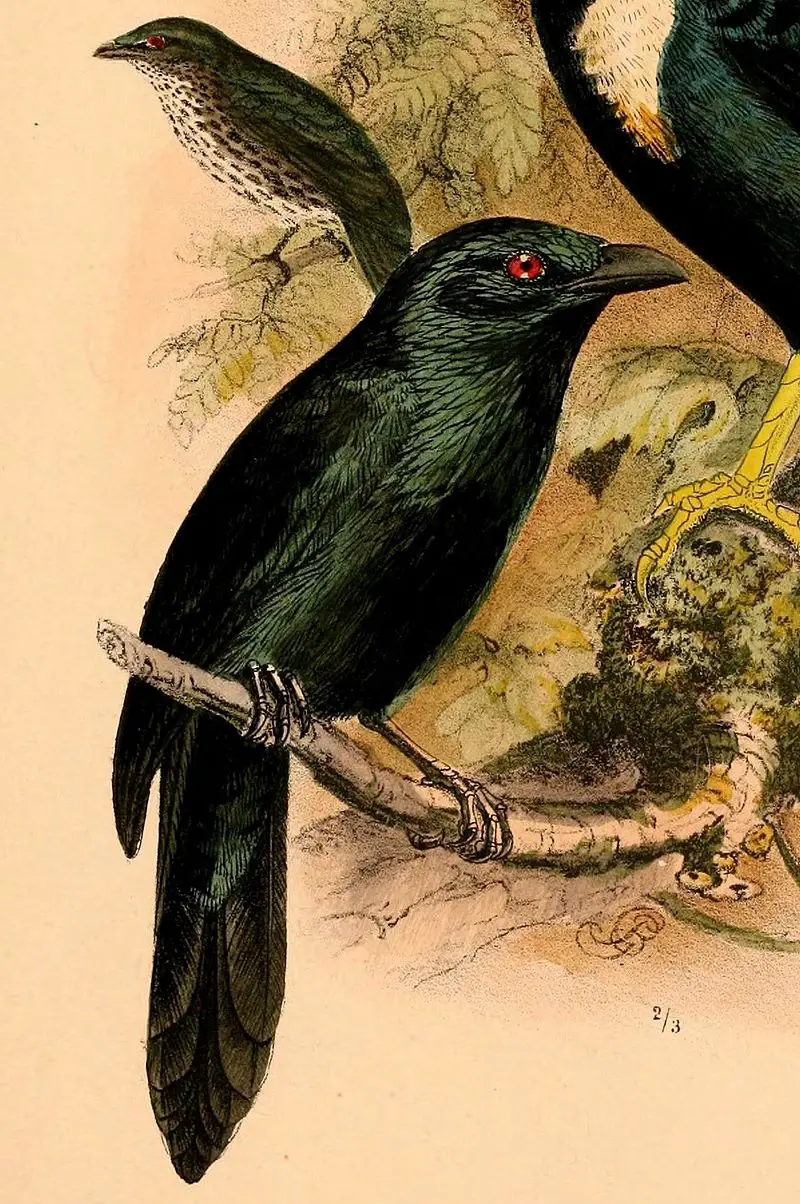
The Moluccan starling is a type of bird that belongs to the starling family. It is found only in Indonesia and is known for its unique appearance. This species is naturally found in lowland forests and mangrove forests.
They have a very specific habitat and have adapted their behavior accordingly. These birds are often seen around water and have a diet that consists of insects and fruit. Moluccan starlings are a vital part of the ecosystem in their native Indonesia.
They contribute to the pollination process and help to control the insect population. Their unique appearance and behavior make them an important part of the natural world.
With its distinctive features and important role in the ecosystem, the Moluccan starling is a fascinating species of bird that is well worth learning more about.Scientific classification:
| Kingdom | Animalia |
| Phylum | Chordata |
| Class | Aves |
| Order | Passeriformes |
| Family | Sturnidae |
| Genus | Aplonis |
| Species | A. mysolensis |
33. Azure Dollarbird
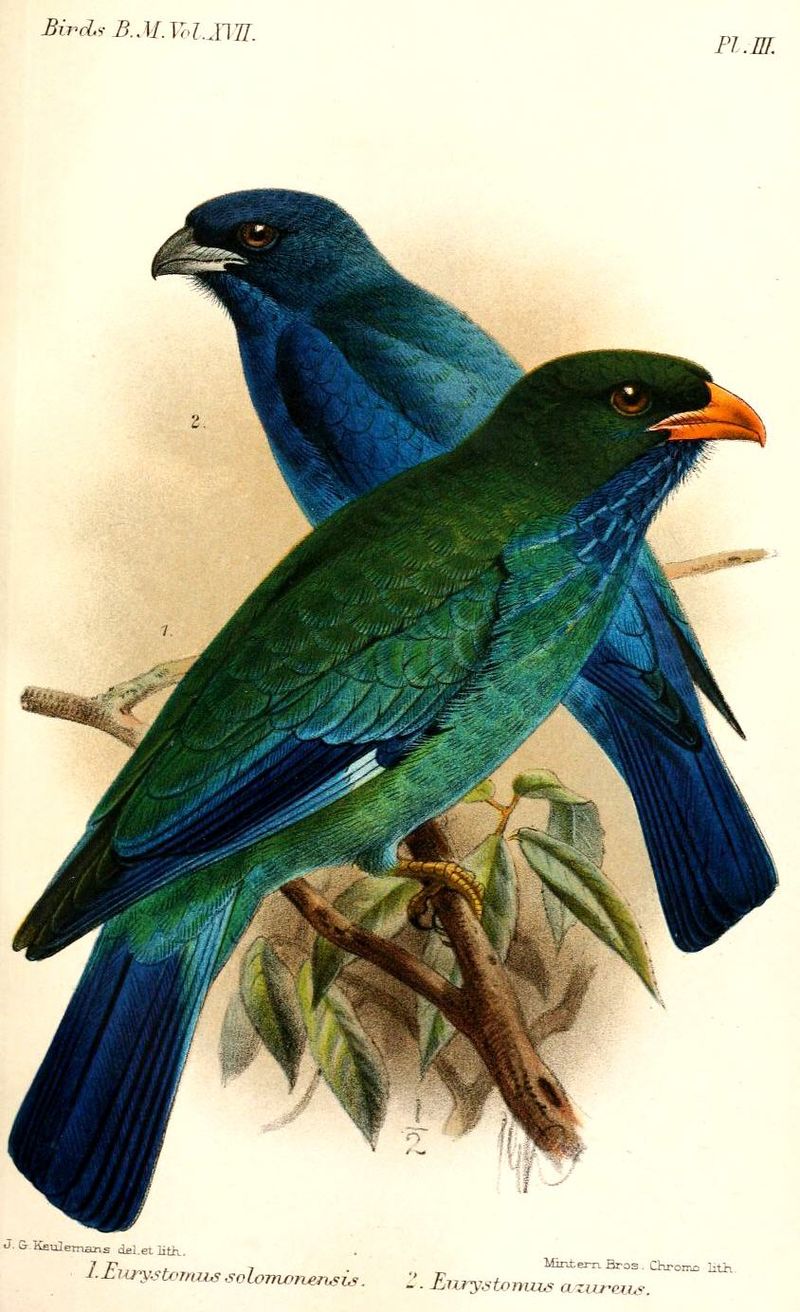
The Azure dollarbird, also known as the purple roller, is a bird species found only in the Maluku Islands of Indonesia. It belongs to the Coraciidae family and was once considered a subspecies of the Oriental dollarbird.
The bird’s name is derived from its blue coloring and round, dollar-shaped bills. It is a graceful and agile flyer that captures insects in mid-air using its sharp beak. Due to habitat loss and hunting, the Azure dollarbird population is at risk of declining.
Conservation efforts are needed to preserve this unique and important species.Scientific classification:
| Kingdom | Animalia |
| Phylum | Chordata |
| Class | Aves |
| Order | Coraciiformes |
| Family | Coraciidae |
| Genus | Eurystomus |
| Species | E. azureus |
34. Grey-Headed Fruit Dove
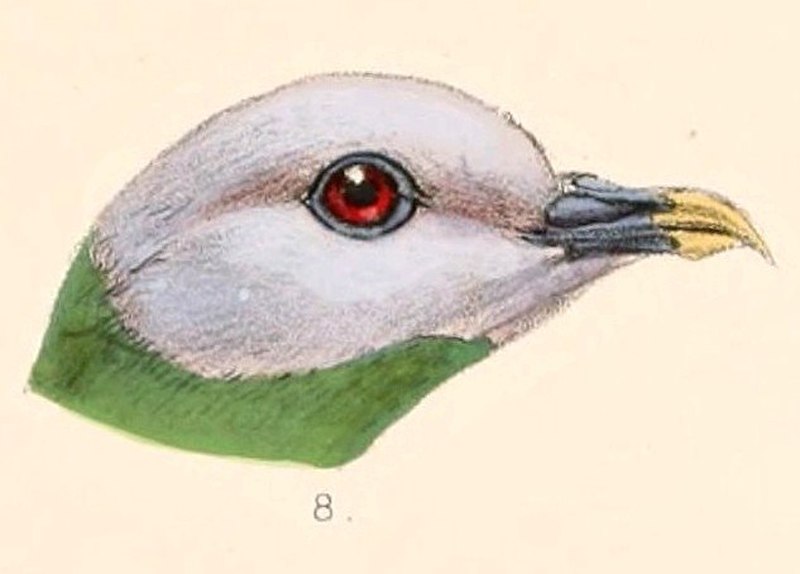
The Grey-headed fruit dove is a bird species belonging to the Columbidae family. It is found exclusively in the northern Moluccas region. This bird prefers to inhabit moist lowland forests in subtropical or tropical regions.
Its plumage is mostly green, but it has a distinctive grey head with red eyes and a black yellow-tipped beak. The Grey-headed fruit dove is a fruit-eating bird and feeds primarily on various types of fruits.
Unfortunately, this bird species is declining in numbers due to habitat destruction, hunting, and trapping for the bird trade.
Conservation efforts are underway to protect this bird and its habitat from further disturbances.Scientific classification:
| Kingdom | Animalia |
| Phylum | Chordata |
| Class | Aves |
| Order | Columbiformes |
| Family | Columbidae |
| Genus | Ptilinopus |
| Species | P. hyogastrus |
35. Moluccan Goshawk

The Moluccan goshawk, also known as the Halmaheran goshawk, is a bird of prey found exclusively in Halmahera, Indonesia. This species belongs to the family Accipitridae and is known for its powerful hunting abilities.
The bird’s natural habitat consists of subtropical or tropical moist lowland forest and subtropical or tropical moist montane forest. The Moluccan goshawk is celebrated for its striking plumage and fierce hunting techniques.
This bird’s unique characteristics have made it a sought-after subject for bird watchers and researchers. Despite its popularity, the Moluccan goshawk is currently facing challenges due to habitat loss and human interference.
Conservation efforts are underway to safeguard this species and its natural habitat. With proper care and protection, the Moluccan goshawk can continue to thrive in its native homeland.Scientific classification:
| Kingdom | Animalia |
| Phylum | Chordata |
| Class | Aves |
| Order | Accipitriformes |
| Family | Accipitridae |
| Genus | Accipiter |
| Species | A. henicogrammus |
36. Rufous-Bellied Triller
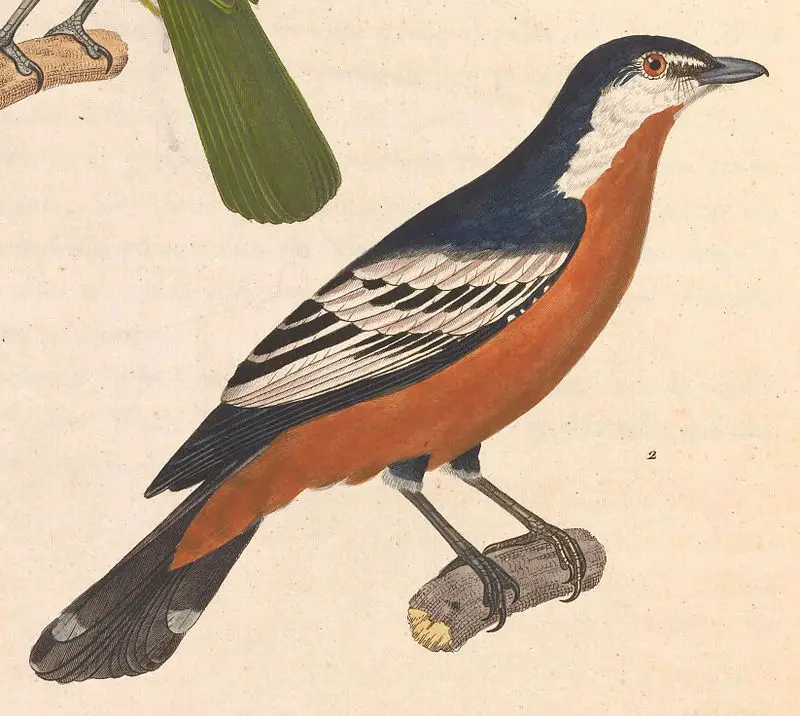
The Rufous-bellied Triller is a small bird found exclusively in the Maluku Islands of Indonesia. Its striking physical features include the rufous-colored belly, which distinguishes it from other birds in the Campephagidae family.
This species thrives in moist lowland forests and mangrove habitats, which provide the necessary environment for these birds to prosper. With their melodic voices, they are known for their ability to create beautiful songs.
These trillers play an integral role in the ecosystem, with their diet consisting largely of insects, making them important contributors to pest control.
Despite their significance, unfortunate habitat loss and deforestation have made them vulnerable to extinction.
However, conservation efforts are ongoing to secure and ensure the survival of these beautiful creatures in the wild.Scientific classification:
| Kingdom | Animalia |
| Phylum | Chordata |
| Class | Aves |
| Order | Passeriformes |
| Family | Campephagidae |
| Genus | Lalage |
| Species | L. aurea |
37. Beach Kingfisher
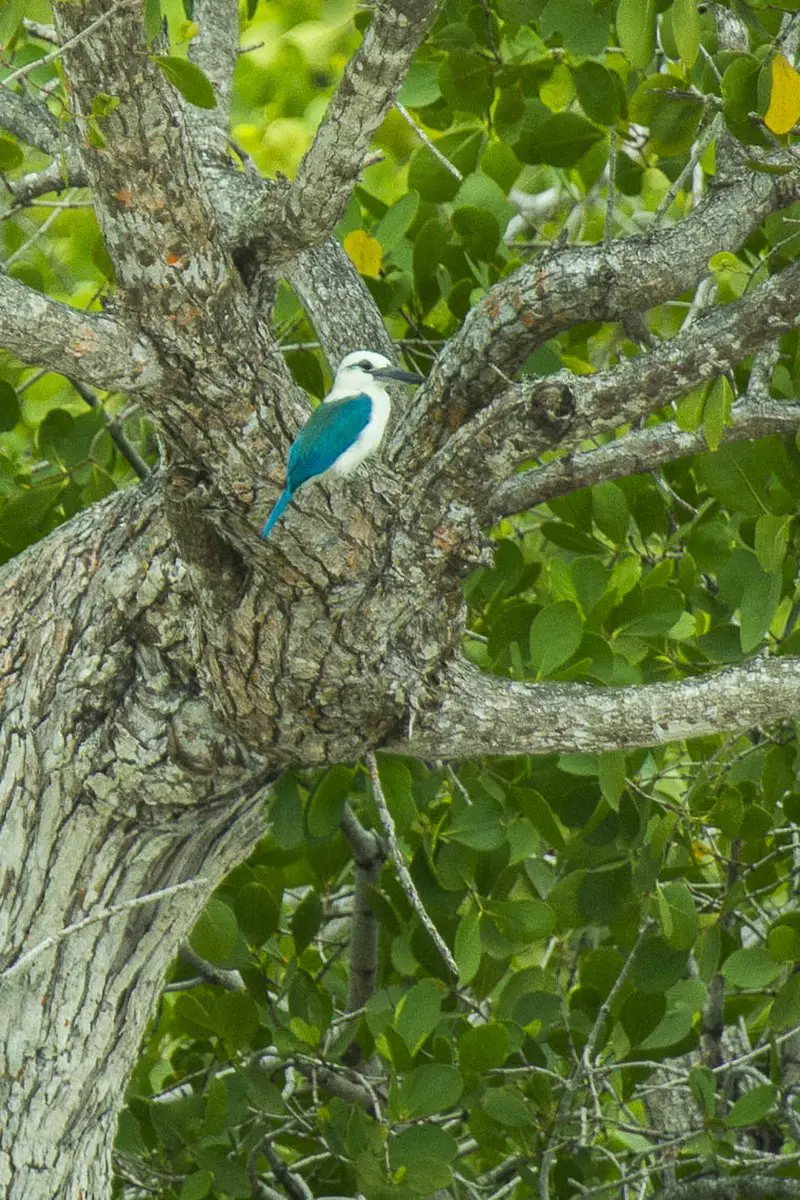
The Beach kingfisher is a species of bird that belongs to the family Alcedinidae. This bird is found in Indonesia, Papua New Guinea, and Solomon Islands.
Its natural habitat is subtropical or tropical mangrove forests. Beach kingfishers are known for their colorful appearance and can be easily spotted due to their bright colors.
They have a distinctive blue and white color with a reddish-orange beak. The Beach kingfisher is not just a beautiful bird, but it also plays an important role in the ecosystem by consuming small fish and invertebrates that live in mangrove forests.
Despite its importance, the Beach kingfisher faces many threats due to habitat loss and human activities. Conservation efforts are underway to protect this unique bird species and its habitat for future generations.Scientific classification:
| Kingdom | Animalia |
| Phylum | Chordata |
| Class | Aves |
| Order | Coraciiformes |
| Family | Alcedinidae |
| Subfamily | Halcyoninae |
| Genus | Todiramphus |
| Species | T. saurophagus |
38. Morotai Friarbird
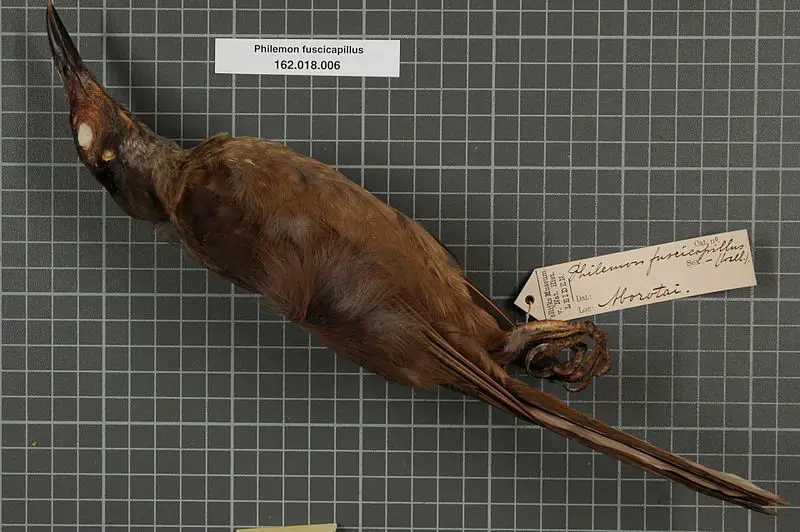
The Morotai friarbird, also known as the dusky friarbird, is a member of the honeyeater family Meliphagidae. This bird is approximately 30 cm long and has a dark brown body with light undersides.
The skin around its eyes is bare and pink in color. The species is often confused with the dusky-brown oriole due to its nearly identical appearance. This mimicry is common in orioles and friarbirds alike.
The Morotai friarbird is a fascinating bird to observe with its distinctive, yet subtle coloring and unique physical attributes.Scientific classification:
| Kingdom | Animalia |
| Phylum | Chordata |
| Class | Aves |
| Order | Passeriformes |
| Family | Meliphagidae |
| Genus | Philemon |
| Species | P. fuscicapillus |
39. Black Sunbird
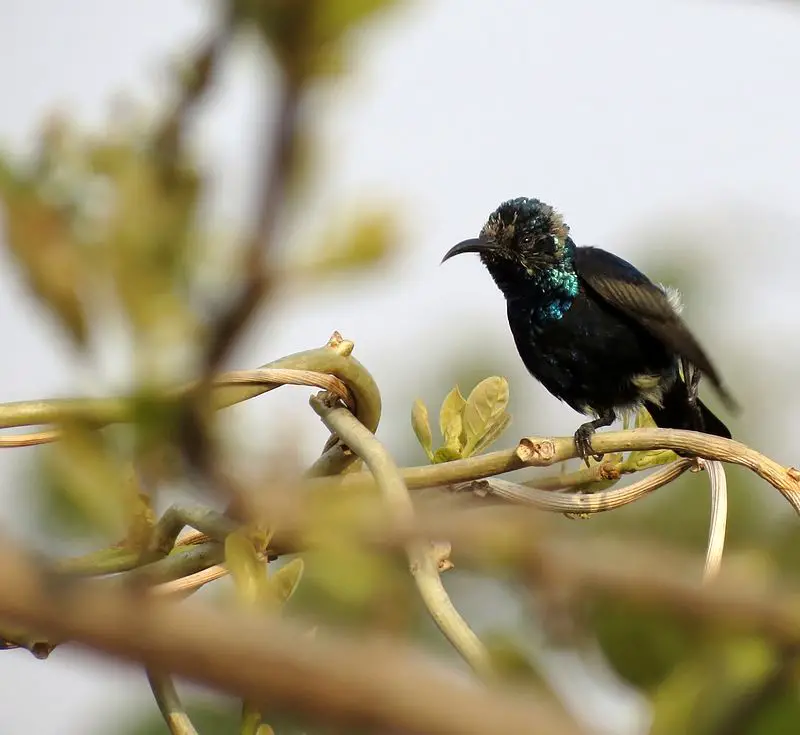
The black sunbird is a small and iridescent songbird with a long down-curved bill. It is found in eastern Indonesia and New Guinea, preferring habitats such as subtropical or tropical moist lowland forest and mangrove forest.
The bird’s average lifespan is around 3.6 years. Its coloring and unique features make it easy to spot amongst other birds in its natural habitat.
Despite its small size, the black sunbird is an important species for pollination, as it feeds on nectar from flowers.
Its place in the ecosystem highlights the importance of protecting and conserving natural habitats for all species to thrive.Scientific classification:
| Kingdom | Animalia |
| Phylum | Chordata |
| Class | Aves |
| Order | Passeriformes |
| Family | Nectariniidae |
| Genus | Leptocoma |
| Species | L. sericea |
40. Moluccan Flycatcher
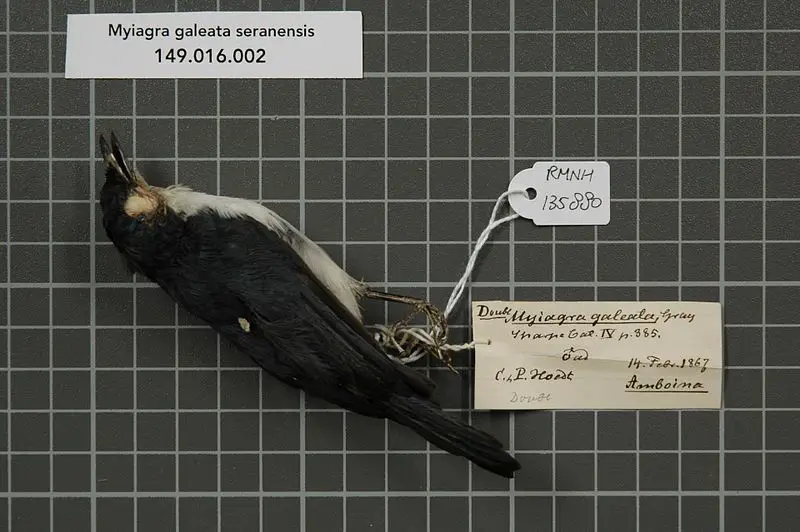
The Moluccan flycatcher, also known as the dark-grey flycatcher, is a bird species found only in Indonesia. It resides in subtropical or tropical moist lowland forests.
This bird belongs to the Monarchidae family and has various other names, including the helmeted flycatcher, helmeted broadbill, and slaty monarch.
The Moluccan flycatcher has a distinct dark-grey appearance and is well-known for its stunning helmet-shaped head.
Its natural habitat makes it a difficult bird to spot, and it’s often found perched on branches, waiting for prey. This fascinating bird species plays a vital role in maintaining ecological balance and is a beloved part of Indonesia’s wildlife.Scientific classification:
| Kingdom | Animalia |
| Phylum | Chordata |
| Class | Aves |
| Order | Passeriformes |
| Family | Monarchidae |
| Genus | Myiagra |
| Species | M. galeata |
41. North Moluccan Pitta
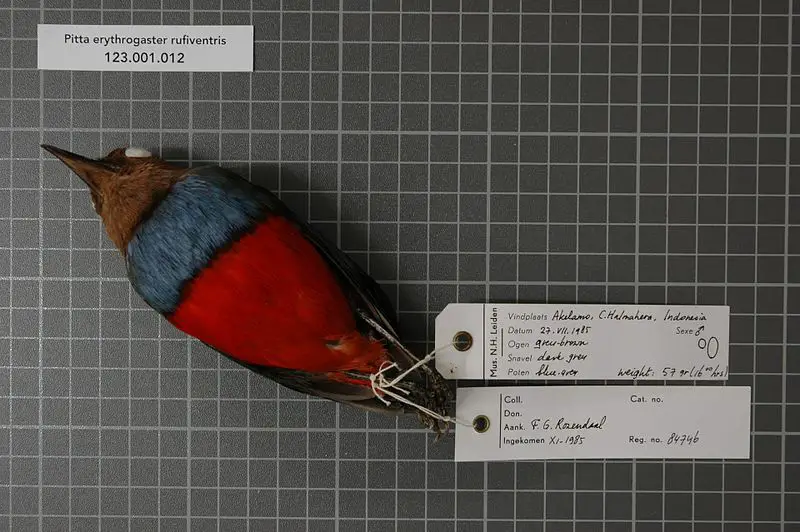
The North Moluccan pitta is a vibrant bird species found only in Indonesia’s northern Moluccas region. It inhabits subtropical and tropical moist lowland forests, with habitat loss being a significant threat.
Previously considered a subspecies of the red-bellied pitta, it is now recognized as a separate species of pitta. Its scientific name is Erythropitta rufiventris.
The North Moluccan pitta is distinguishable for its striking, colorful plumage and a distinctive call.
Unfortunately, due to habitat loss, the population of this bird species is declining. Conservation efforts must be taken to preserve their natural habitat to prevent the North Moluccan pitta from becoming endangered.
They are a unique and essential component of their ecosystem and must be protected.Scientific classification:
| Kingdom | Animalia |
| Phylum | Chordata |
| Class | Aves |
| Order | Passeriformes |
| Family | Pittidae |
| Genus | Erythropitta |
| Species | E. rufiventris |
42. Island Whistler
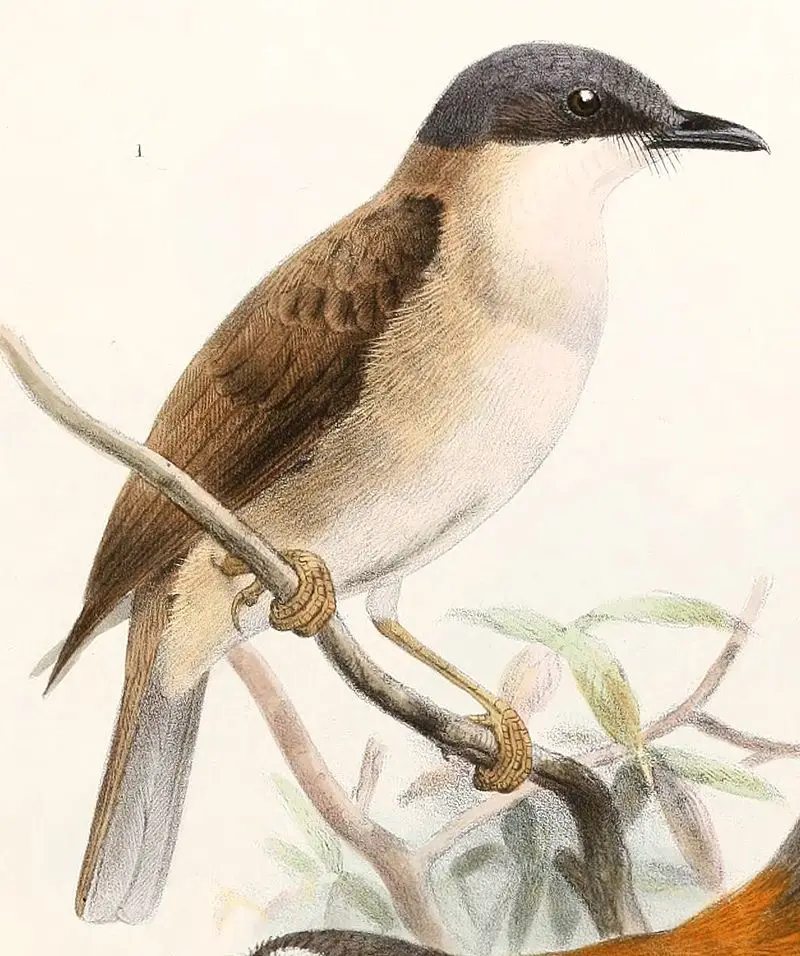
The island whistler bird is endemic to the Moluccas in Indonesia. This species belongs to the Pachycephalidae family and is commonly found in subtropical or tropical dry forests and mangrove forests.
Initially, it was classified under the genus Myiolestes, which is now considered a synonym for Colluricincla.
The island whistler has a unique appearance with its distinct coloration and sharp beak. Its body size is small and agile, enabling swift movements to glide through dense forests.
Even though this species is widely distributed in its natural habitat, little is known about its behavior and patterns in the forest ecosystem.
Biologists are constantly on the lookout to gather more insights into the life of this fascinating bird species.Scientific classification:
| Kingdom | Animalia |
| Phylum | Chordata |
| Class | Aves |
| Order | Passeriformes |
| Family | Pachycephalidae |
| Genus | Pachycephala |
| Species | P. phaionota |
43. Spectacled Imperial Pigeon
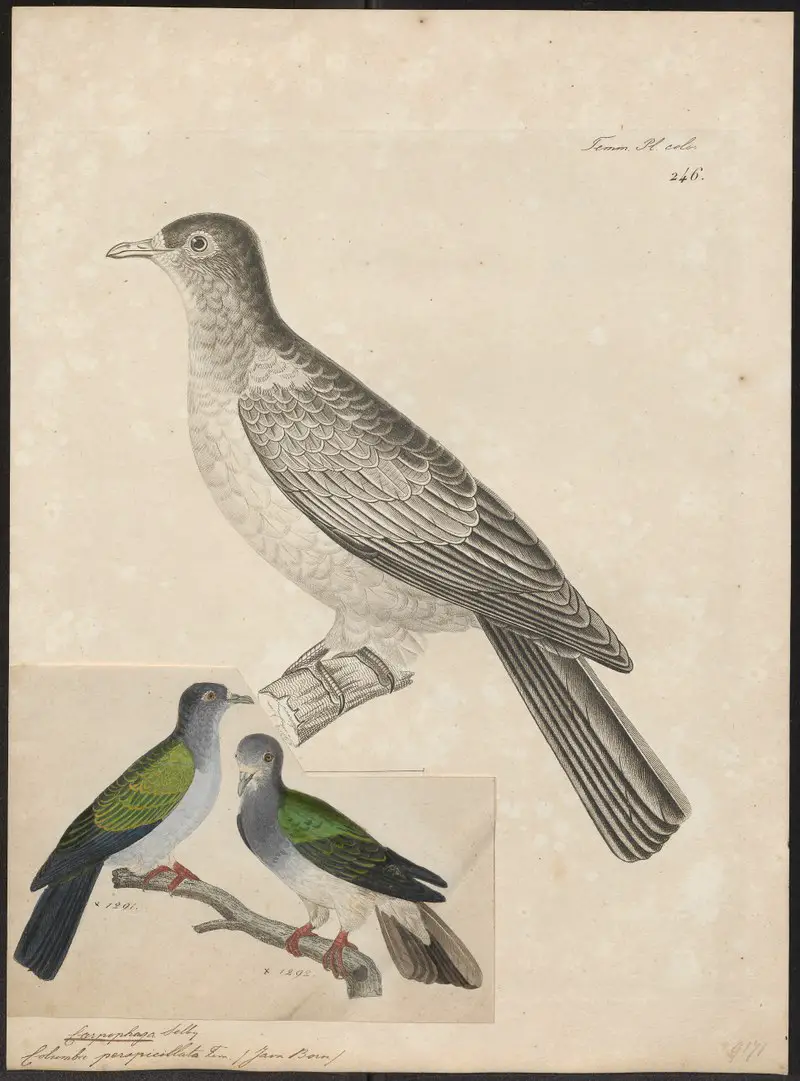
The Spectacled imperial pigeon is a bird native to the Maluku Islands. It belongs to the family Columbidae and is most closely related to the Se within the Ducula genus.
This species can be found inhabiting subtropical or tropical mangrove forest and moist lowland forest. Its name comes from the distinct spectacles-like markings around its eyes.
It has a plump body and a rounded head with a short neck. Its wings are long and strong for flying over long distances.
With its distinctive markings and habitat preferences, the Spectacled imperial pigeon is a unique and important species in its ecosystem.
Conservation efforts are necessary to protect this bird’s natural habitats and ensure its continued existence.Scientific classification:
| Kingdom | Animalia |
| Phylum | Chordata |
| Class | Aves |
| Order | Columbiformes |
| Family | Columbidae |
| Genus | Ducula |
| Species | D. perspicillata |
44. Sultan’s Cuckoo-Dove
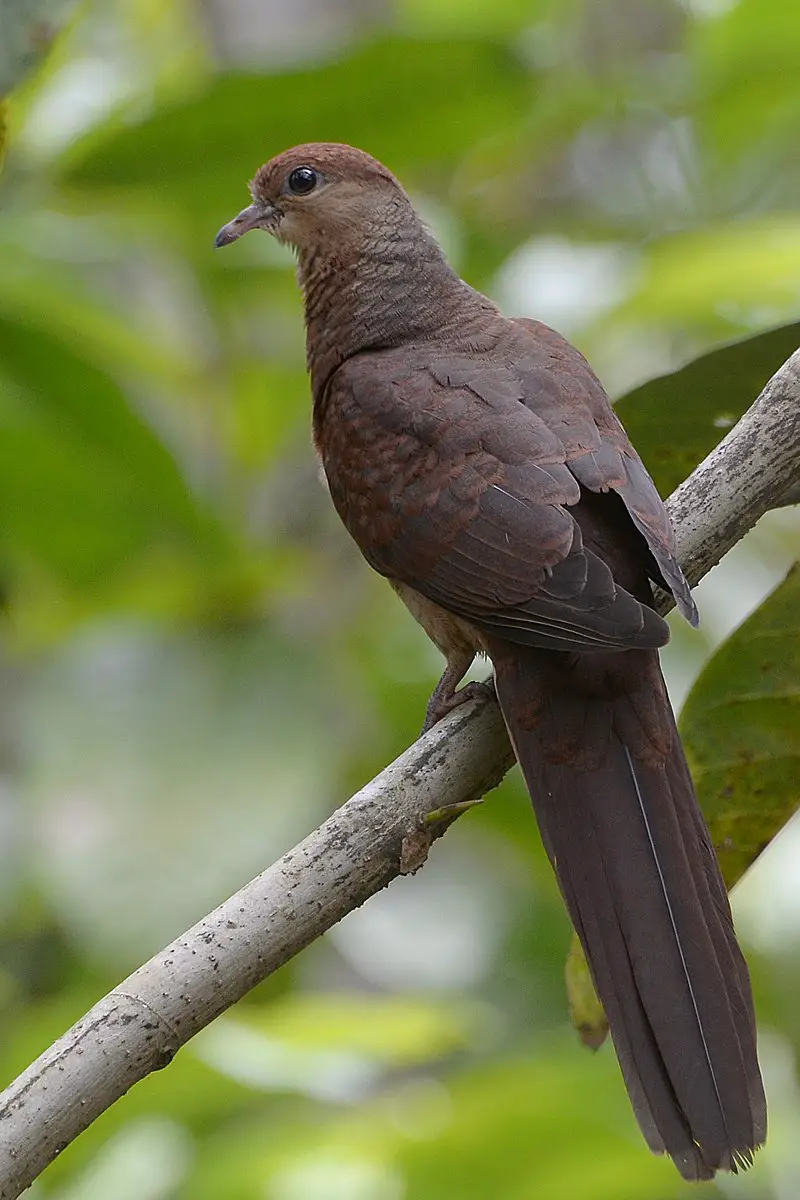
The Sultan’s cuckoo-dove is a species of dove found in the northern Moluccas, Sulawesi, New Guinea, and the western Papuan islands.
It was identified as one of the three new species when the slender-billed cuckoo-dove was divided in 2016.
These birds are generally 35-37 centimeters long, and the males have a subtle pink and green coloring on their nape and neck.Scientific classification:
| Kingdom | Animalia |
| Phylum | Chordata |
| Class | Aves |
| Order | Columbiformes |
| Family | Columbidae |
| Genus | Macropygia |
| Species | M. doreya |
45. Turquoise Flycatcher
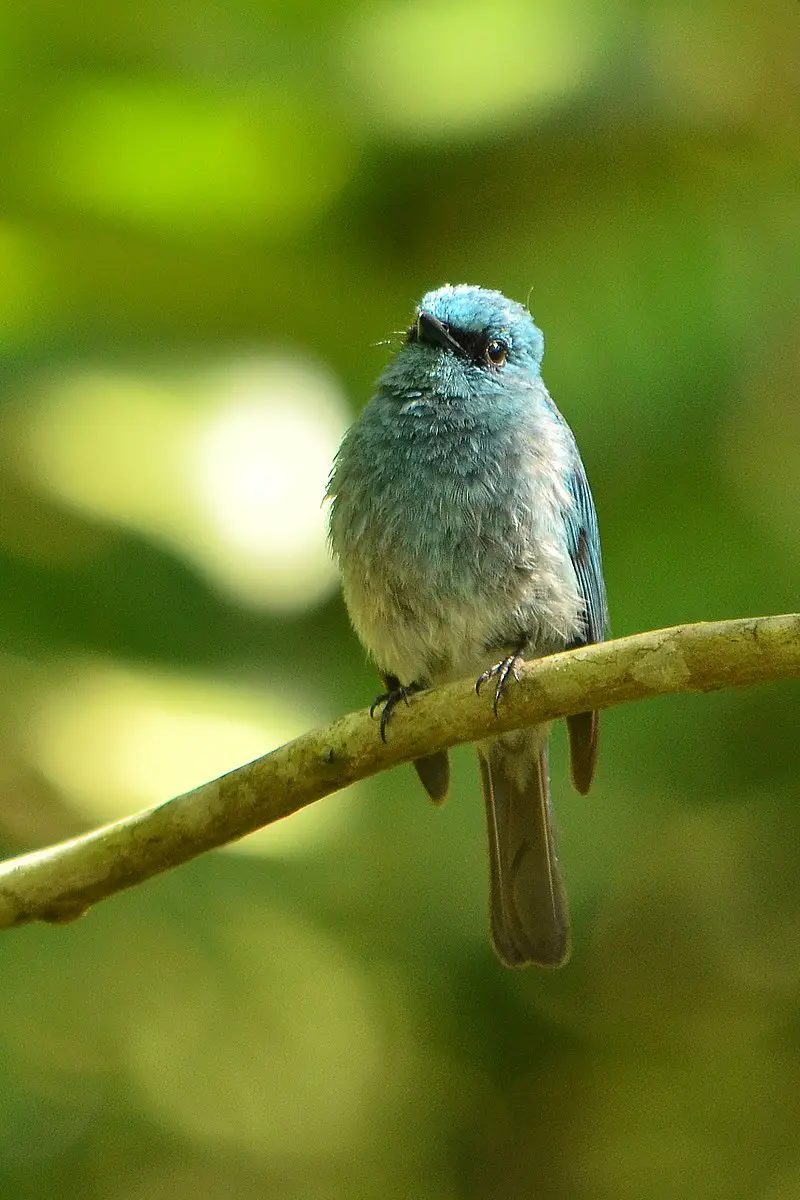
The turquoise flycatcher bird is a member of the Muscicapidae family. It can be found in the lush, subtropical forests of Indonesia and the Philippines.
Aptly named for its beautiful turquoise color, this small bird is also known as the island flycatcher. It thrives in moist, montane forests and flits through the trees in search of insects for food.
Despite its small size, it has a loud and clear whistle-like call that echoes through the forest. This stunning bird is a testament to the beauty and diversity of the natural world.Scientific classification:
| Kingdom | Animalia |
| Phylum | Chordata |
| Class | Aves |
| Order | Passeriformes |
| Family | Muscicapidae |
| Genus | Eumyias |
| Species | E. panayensis |
Also Featured In: Most Common Birds in Negros, Mindoro Birds You Should Know